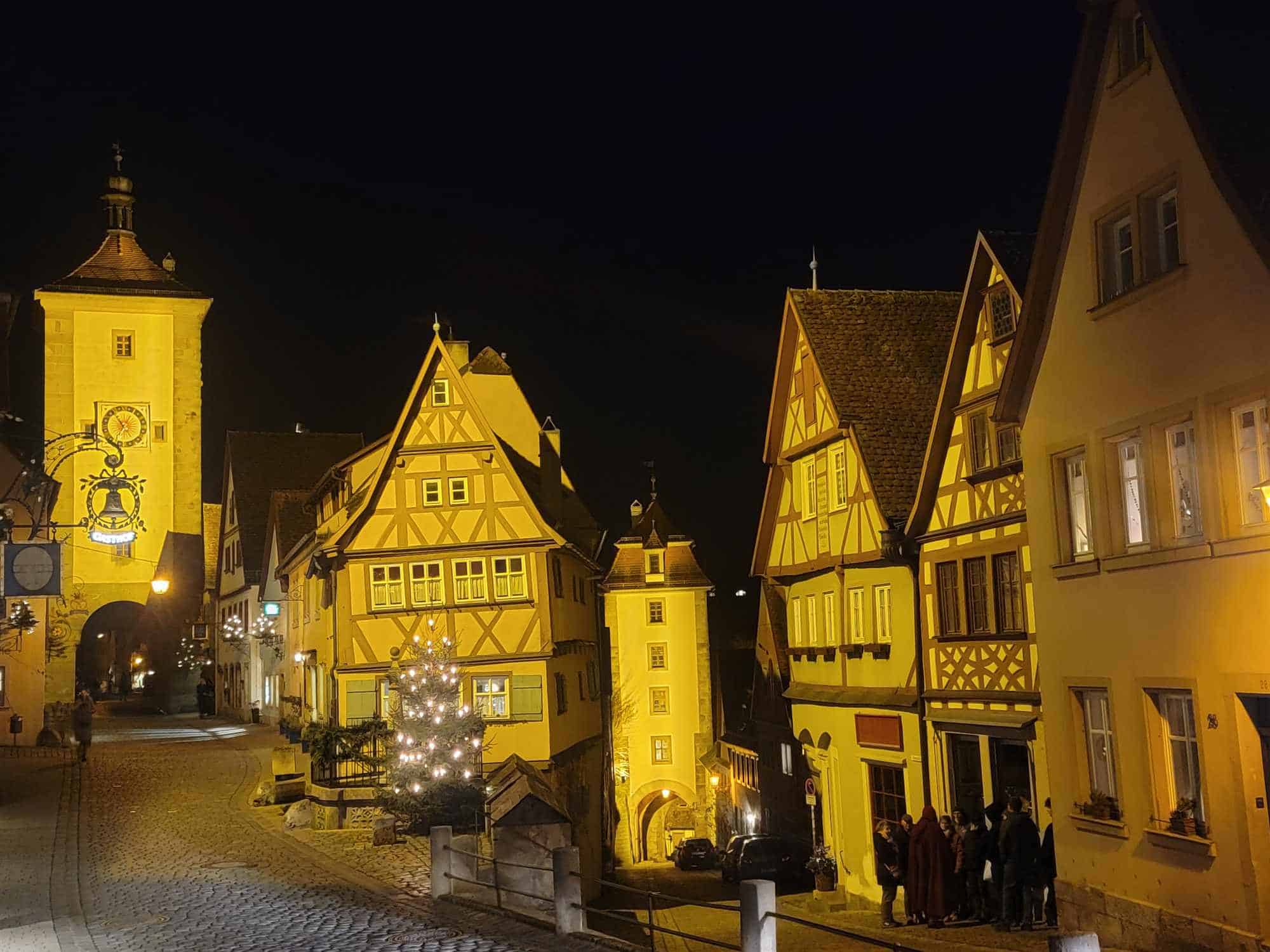It’s the closest thing you’ll ever get to having a time machine with its dial set to Medieval Europe, and there’s also a ton of really cool things to do in Rothenburg ob der Tauber! Here are all my favorites in an in-depth guide that will tell you everything you need to know about this storybook destination!
Explore!
1) Wander
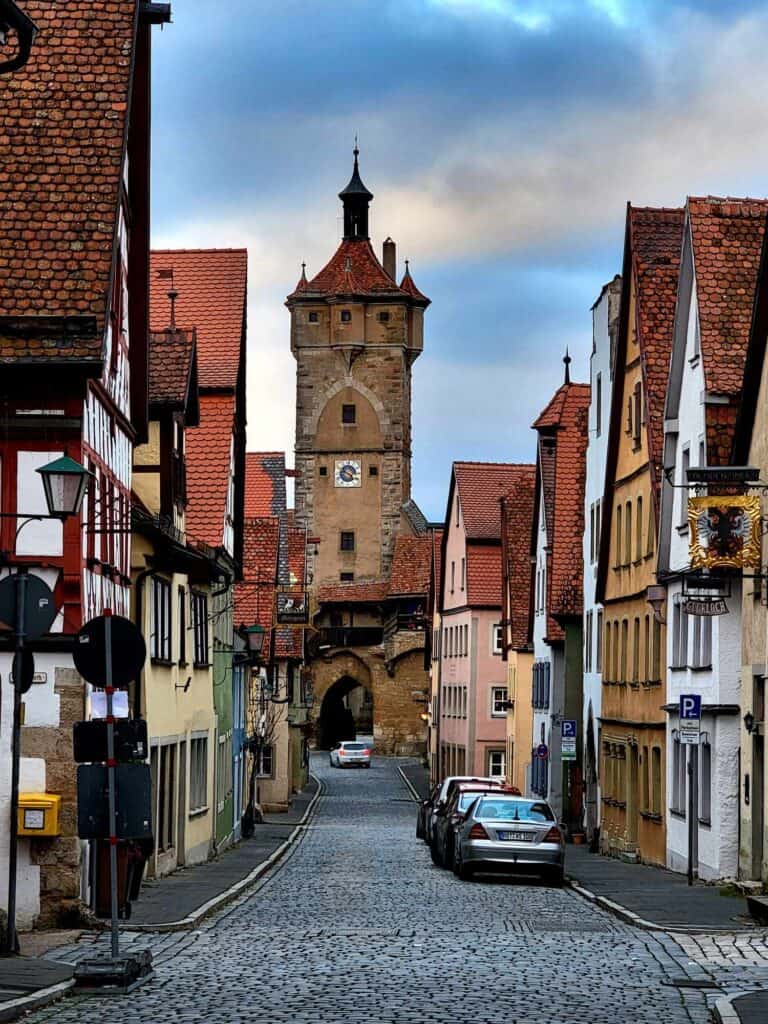
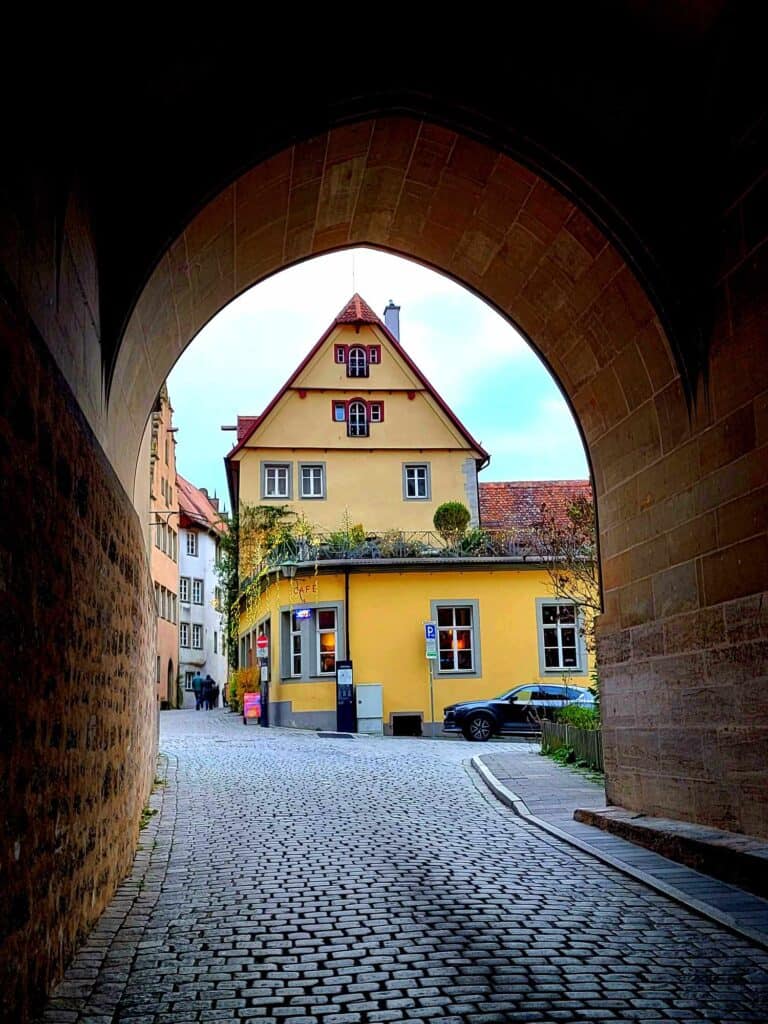
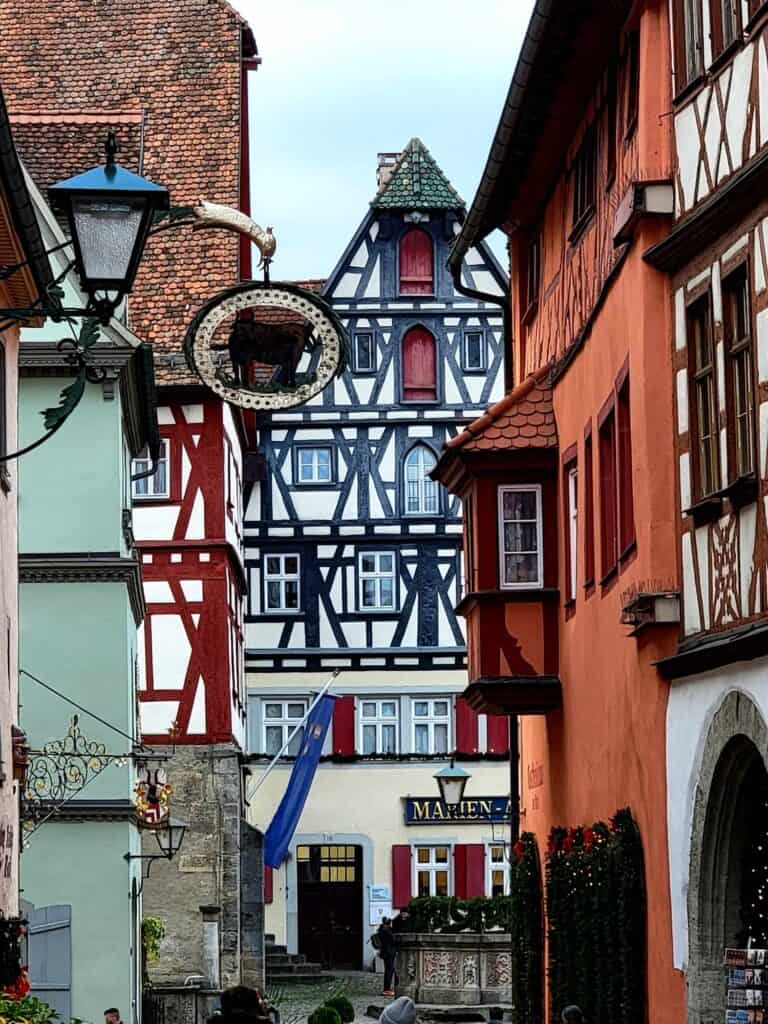
My best advice is to start your adventure in Rothenburg with a couple hours of unstructured, unhurried wandering. It took me a while to just acclimate myself to what I was seeing. The cobblestone streets, the quirky half-timbered buildings, the magical bakeries, the enchanting shops, the intricate stone carvings and fountains, the towers and spires… it felt like a dream.
So let yourself be an explorer. Of all the things to do in Rothenburg ob der Tauber, this is the absolute best. Take pictures, turn corners, make discoveries, soak it in, and then get ready to be captivated and fall in love with this incredible place!
Explore the History and Culture
2) Rothenburg Museum
Klosterhof 5, 91541 Rothenburg ob der Tauber
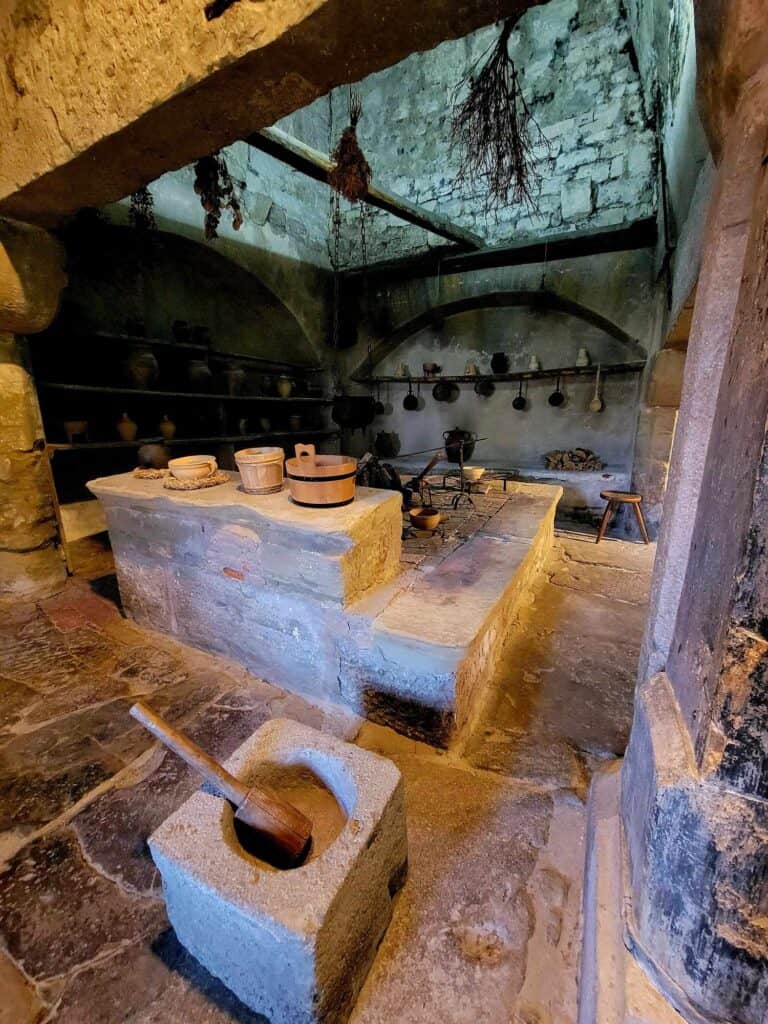
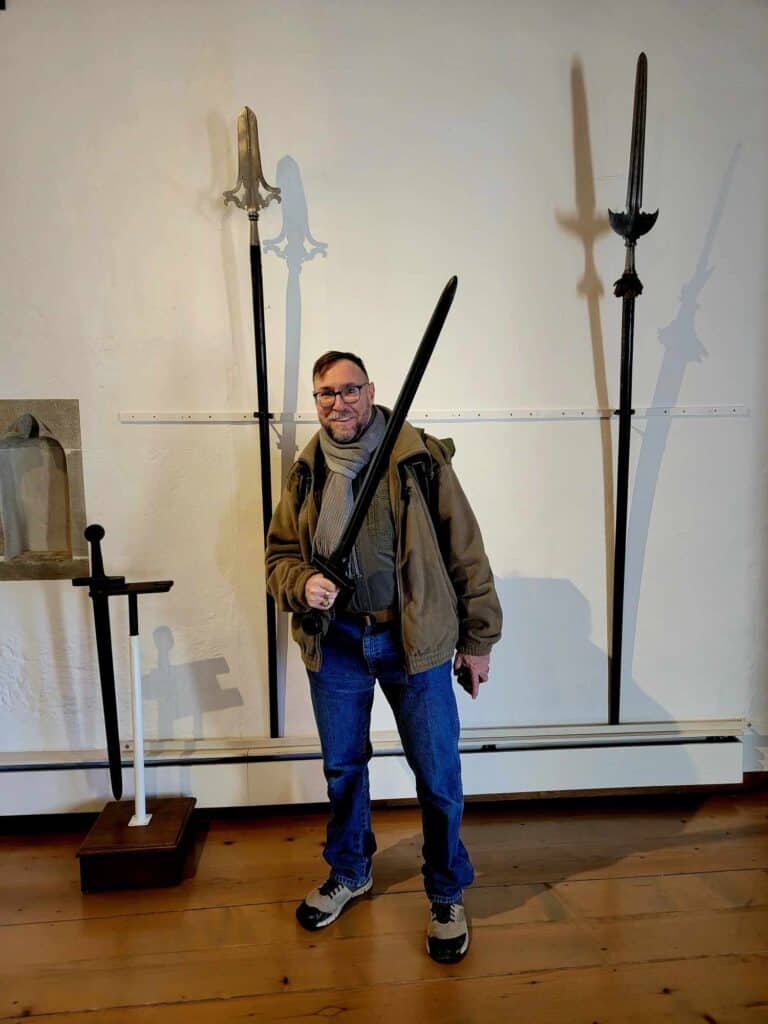
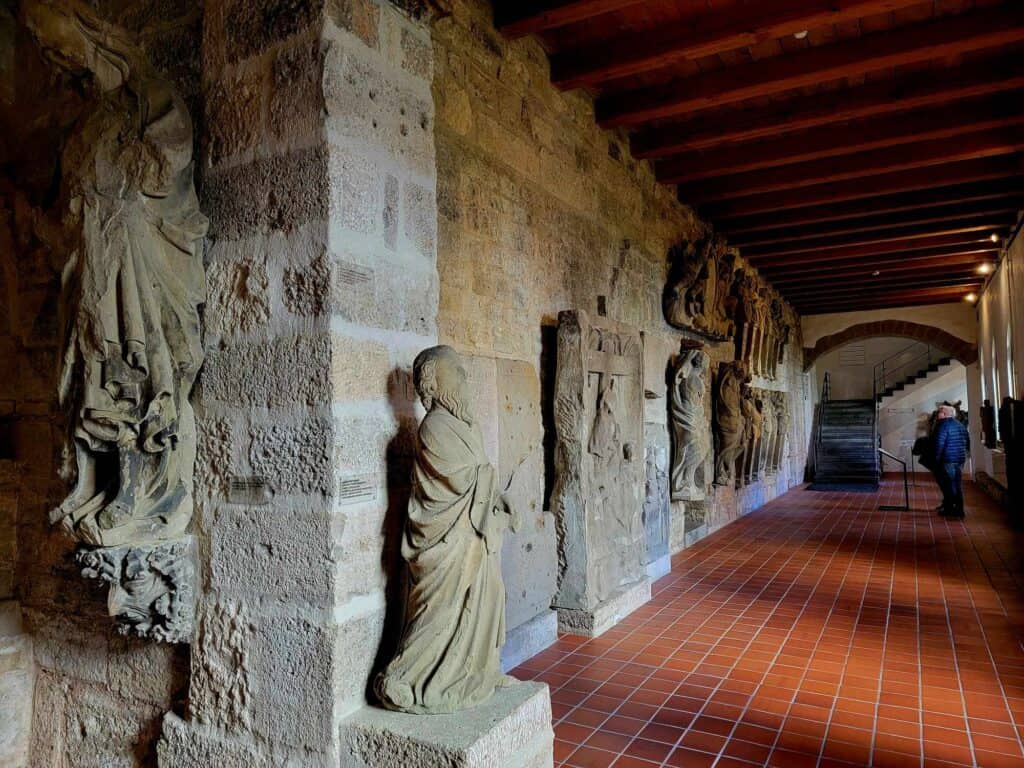
The Rothenburg Museum of History is housed in a former 13th century Dominican convent. The building is gorgeous, and the collection of artifacts is a window into the town’s past.
There is lots to see but some of the real highlights are:
- Medieval Weaponry and Armor: They have a nice collection of swords, pikes, and suits of armor that reflect the military history of the region. There’s even a fun photo opp with a replica sword.
- Kitchen from the Old Convent: This was really cool. There’s a large and fully preserved medieval kitchen which was completely empty when we visited. It was like walking back in time and you could really imagine the nuns preparing food in there.
- Jewish Artifacts: These can be hard to come by but this museum had a nice little collection of Jewish artifacts. There were even gravestones from the 13th century nicely presented in their own room.
- Religious Art: There are lots of intricately carved altarpieces and religious stone sculptures, some are originals from the church which have been replaced by copies in order to preserve the originals here, and save them from environmental damage.
Allow one to two hours to fully explore the museum and its many levels. We almost left at one point and then realized there was a whole floor we hadn’t seen yet!
Admission is €6 for adults and well worth it. I really enjoyed this museum and loved the fact that it was in this old convent building. The staff was also very friendly.
You’ll have to be intentional about planning your visit here, since the opening hours are only 2-5pm. We arrived at 4:45 and had to come back the next day. They are open 7 days a week, though, which is nice.
3) Mittelalterliches Kriminalmuseum (Medieval Crime and Justice Museum)
Burggasse 3-5, 91541 Rothenburg ob der Tauber
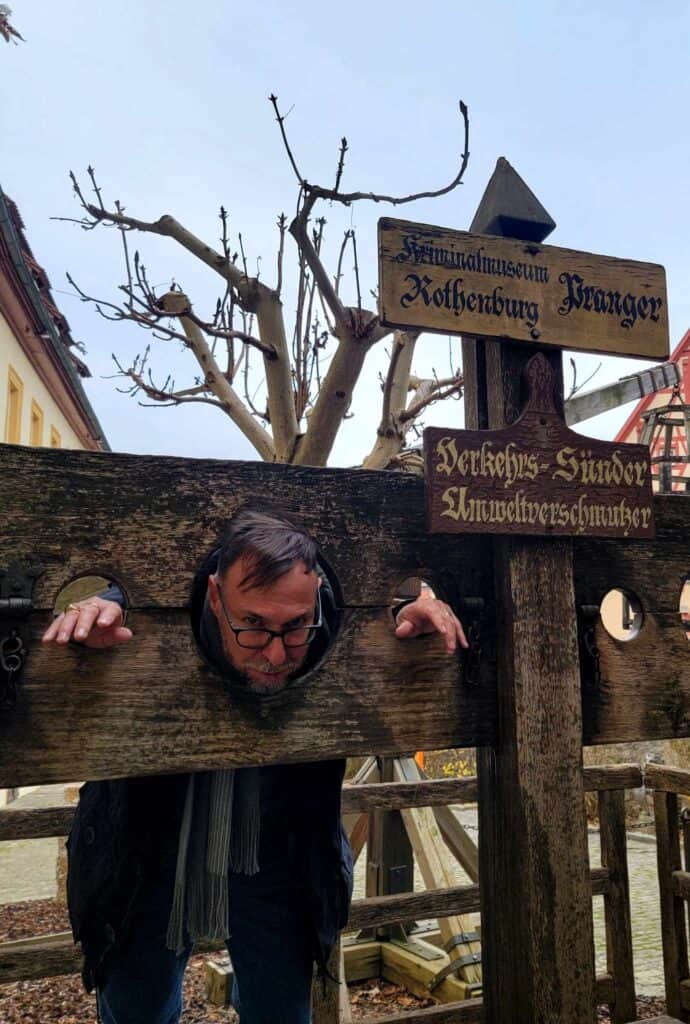
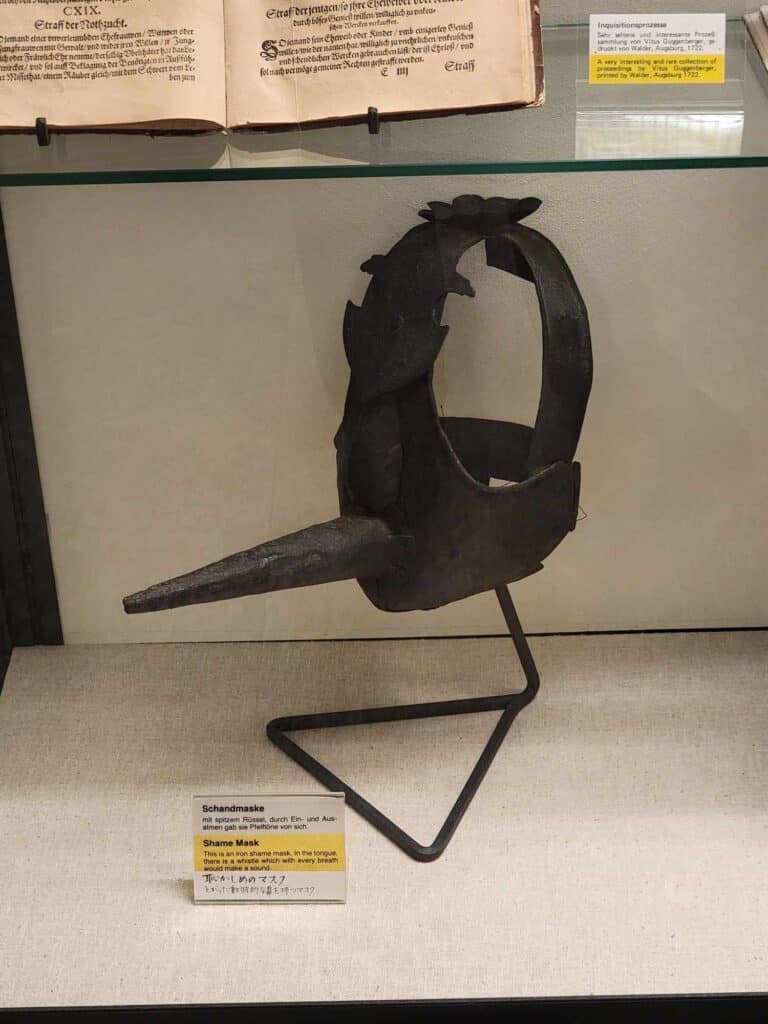
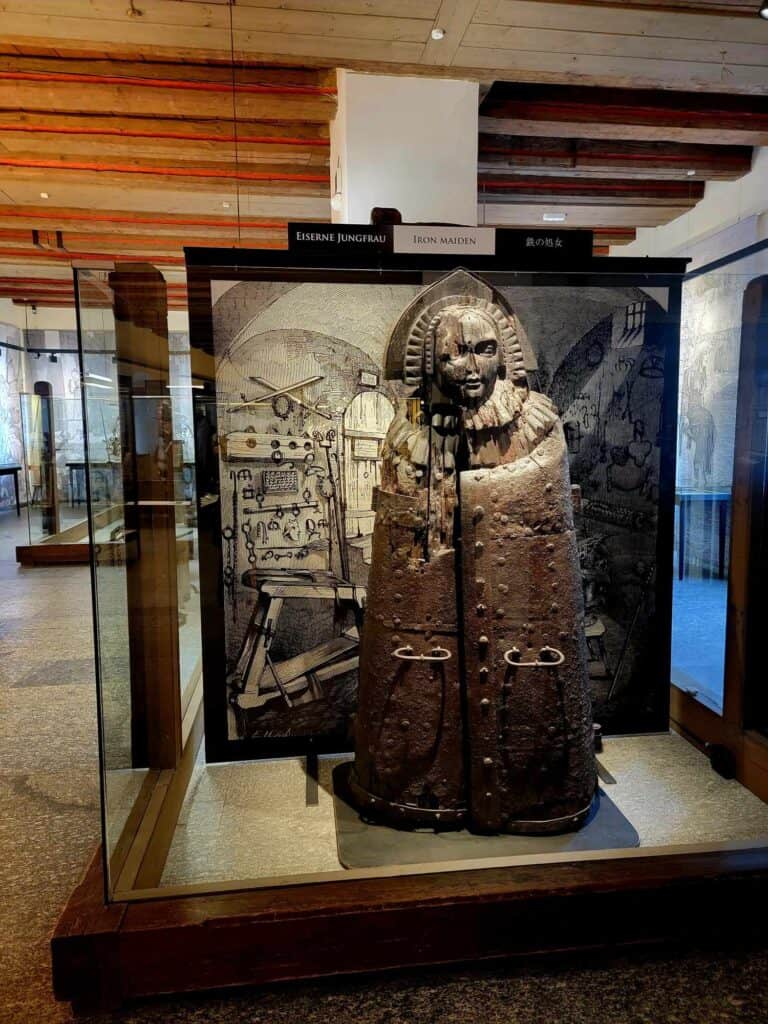
This museum was a LOT to process. I heard it referred to several times as “The Torture Museum.” It was absolutely fascinating, and anyone who is interested in the law and jurisprudence, or criminal justice should definitely check it out. It’s full of information and a really eye-opening look at crime and punishment in medieval times.
There is a lot of written description which is in English as well as German. This really helps explain what you are seeing, and provides a good deal of historical context, and evolution of the justice system over the centuries. It covers the medieval period all the way through the Nazi era.
However, a lot of it is tough to think about. If you are a squeamish person or are a little freaked out at the idea of torture, misery, and human injustice it may be best to take a pass. It’s not gory, but it could definitely be upsetting.
In the museum you’ll find:
- Torture Devices: A chilling array of instruments used for punishment and interrogation. There is also a fairly old replica of the infamous “iron maiden.”
- Legal Documents: I kind of nerded out on these a little. There are lots of rare manuscripts and edicts that reveal how laws (many unjust) were enforced in medieval times.
- Shame Masks and Pillories: Public humiliation was definitely a thing. There is a whole section dedicated to artifacts that people had to wear in public to humiliate them for their various transgressions including crimes we’d recognize today, but also for things like falling asleep in church, or being an outspoken woman.
Free to See Outside the Museum
There are a couple things outside the museum that may be of interest, even if you opt not to go inside. There’s a pillory outside (see picture above) where you can be “imprisoned” for a photo opp.
And especially for fans of the old classic movie Chitty Chitty Bang Bang, you’ll see the actual prop wagon used by the child catcher in the movie. Part of the movie was filmed in Rothenburg, and this old piece of Hollywood found its final home here.
The pillory and the child catcher wagon are both free to check out.
Admission is €9.50 for adults and less for seniors, kids, and groups. Hours are 9:30-4:00 Monday through Friday, and 1:00-4:00 on Saturday and Sunday but may change seasonally. Check the museum’s excellent website for details.
🐾 Dogs are allowed in at no charge but must be kept on a leash.
4) Alt-Rothenburger Hadwerkerhaus (Old Craftman’s House)
Alter Stadtgraben 26, 91541 Rothenburg ob der Tauber
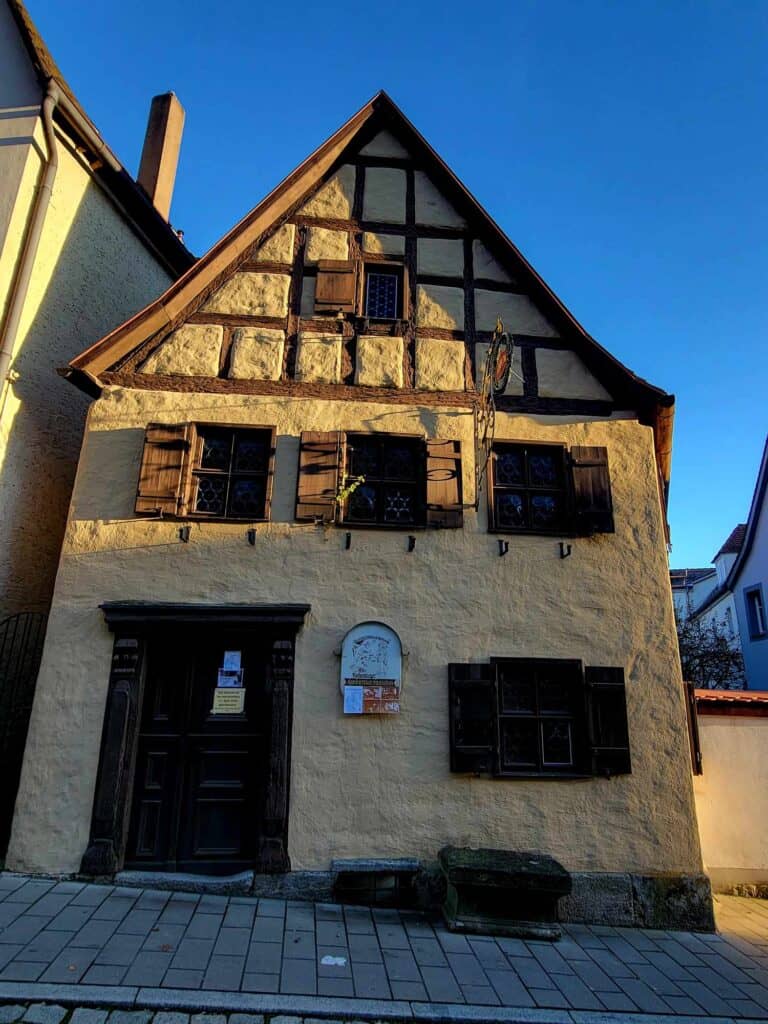
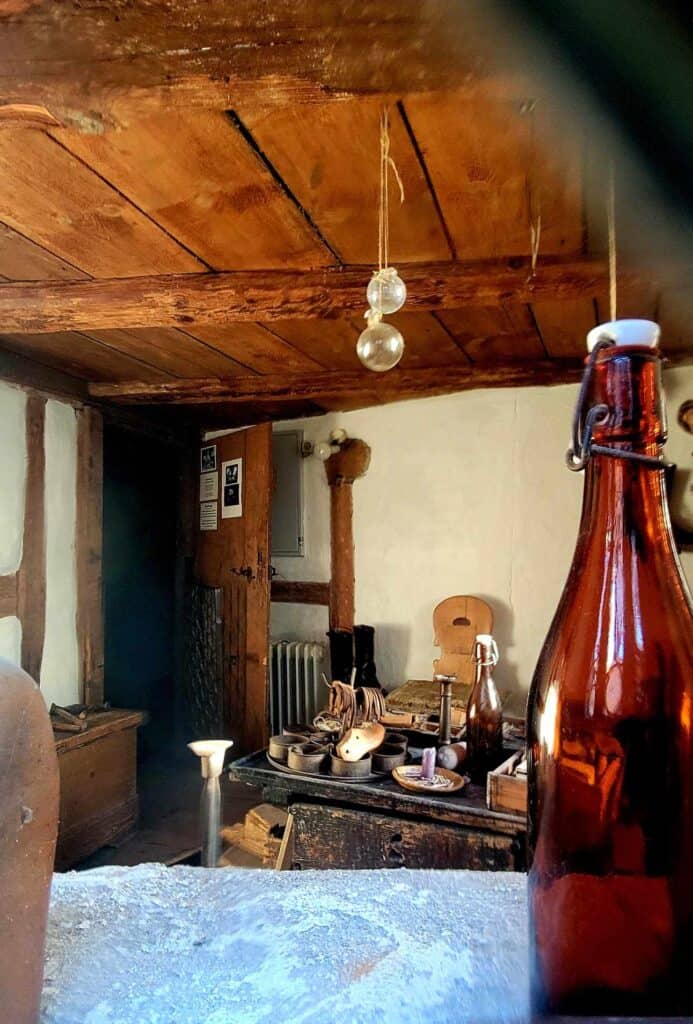
This historical building from 1270 has housed many craftsmen over the centuries. During the time when many homes in the town were being modernized on the inside, this one happened to be occupied by a famous hermit who never changed a thing. Thanks, hermit!
So this building is likely the most historically accurate building of its kind you may ever see. You can see authentic furniture, tools, and household items through the ages, and know that the inside walls, low ceilings, and structure of the house is just as it would have been in the middle ages.
Allow about 20 minutes or so to see the whole thing.
Here’s the Old Craftsman’s House official website which has opening hours listed.
5) St. Jacob’s Church (St. Jakobskirche)
Kirchplatz
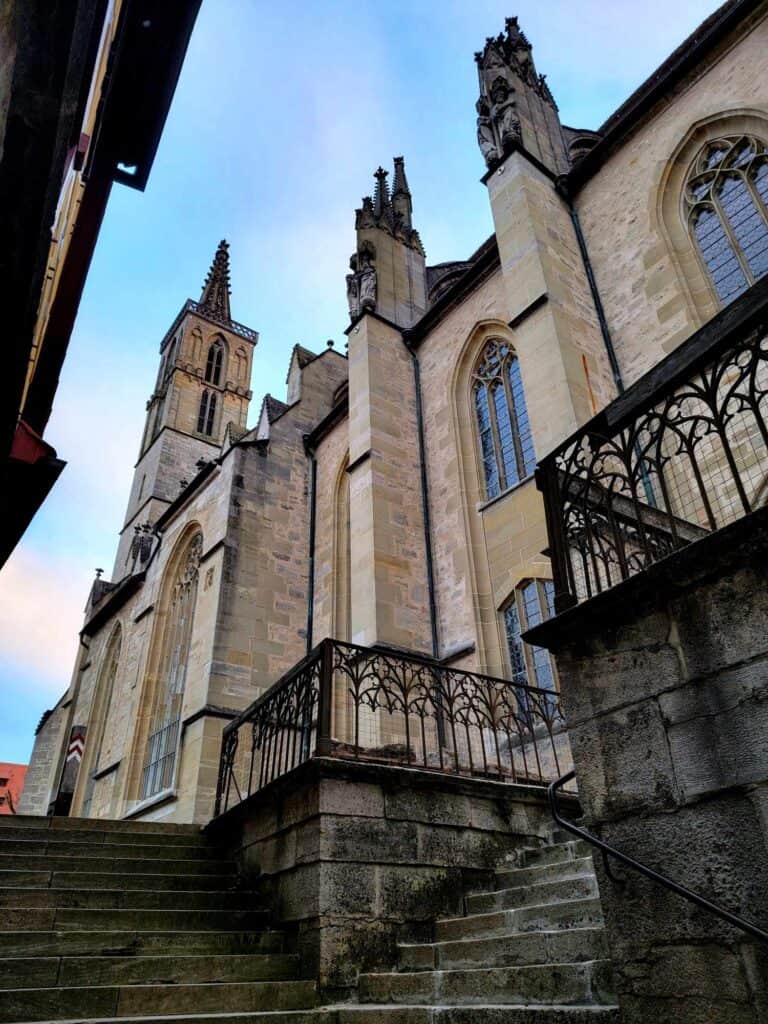
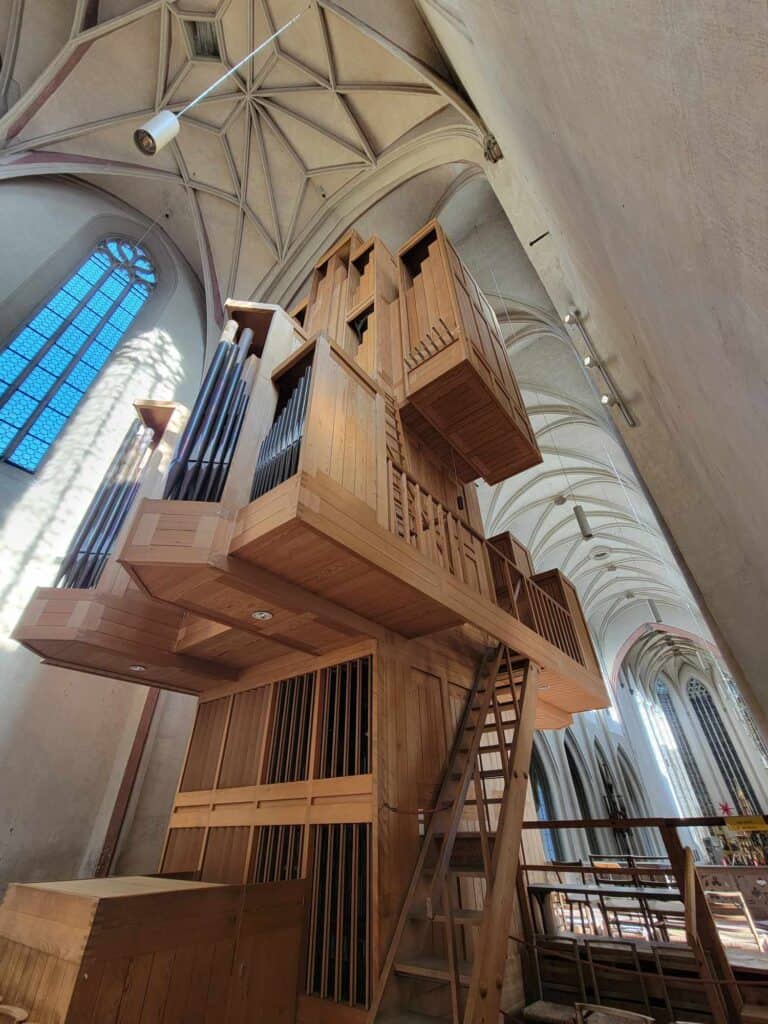
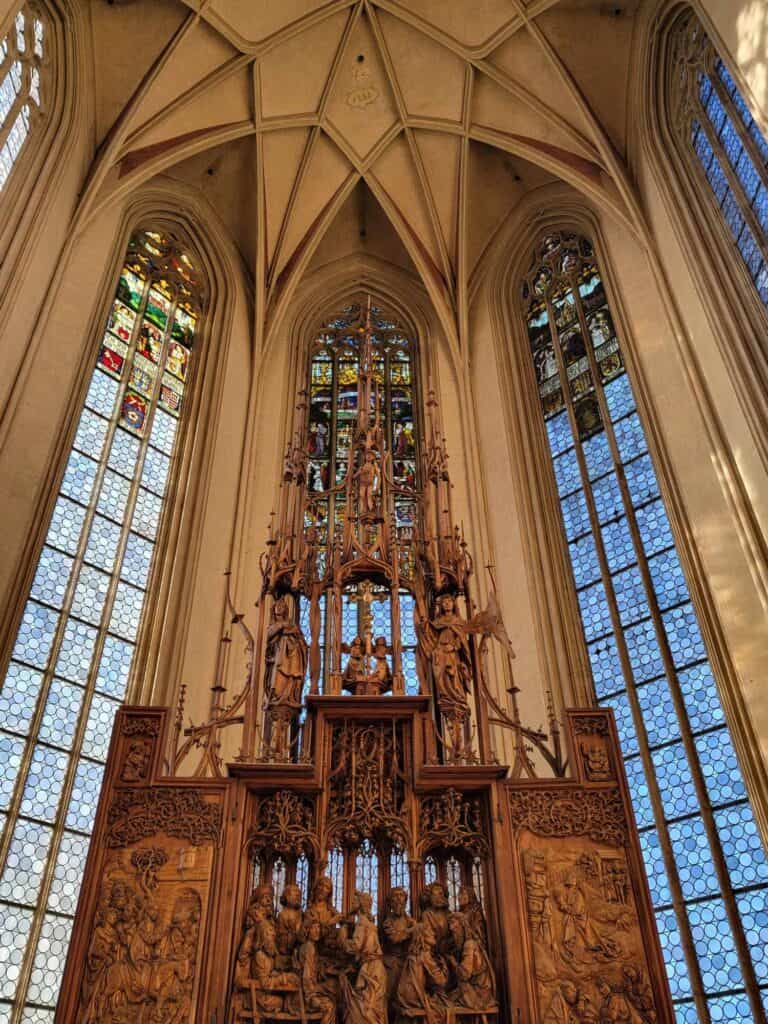
Definitely pop in to this striking and very tall 14th century Gothic church in the heart of the Old Town. It. has undergone a couple renovations, most notably after some damage which occurred during the 30 Years War in the 17th century. But amazingly it still has original stained glass windows which date from the 14th to the 16th century!
Inside make sure you check out the altar piece! It’s quite stunning, carved out of wood, and created by Renaissance artist Tilman Riemenschneider. One of the truly great works of German Renaissance art, it depicts the assumption of the Virgin Mary.
There are several other sculptures by Riemenschneider in the church as well. It’s open daily from 10-5pm. Last entry is at 4:45.
Jewish Memorials and Religious History
6) Old Jewish Cemetery Site and Plaque
Located on the site of the former Jewish cemetery in what is now Schrannenplatz, you’ll find a descriptive plaque that commemorates the Jewish community that flourished in Rothenburg during the Middle Ages before they were expelled in 1520.
7) Rabbi Meir Garden and Former Jewish Community Hall
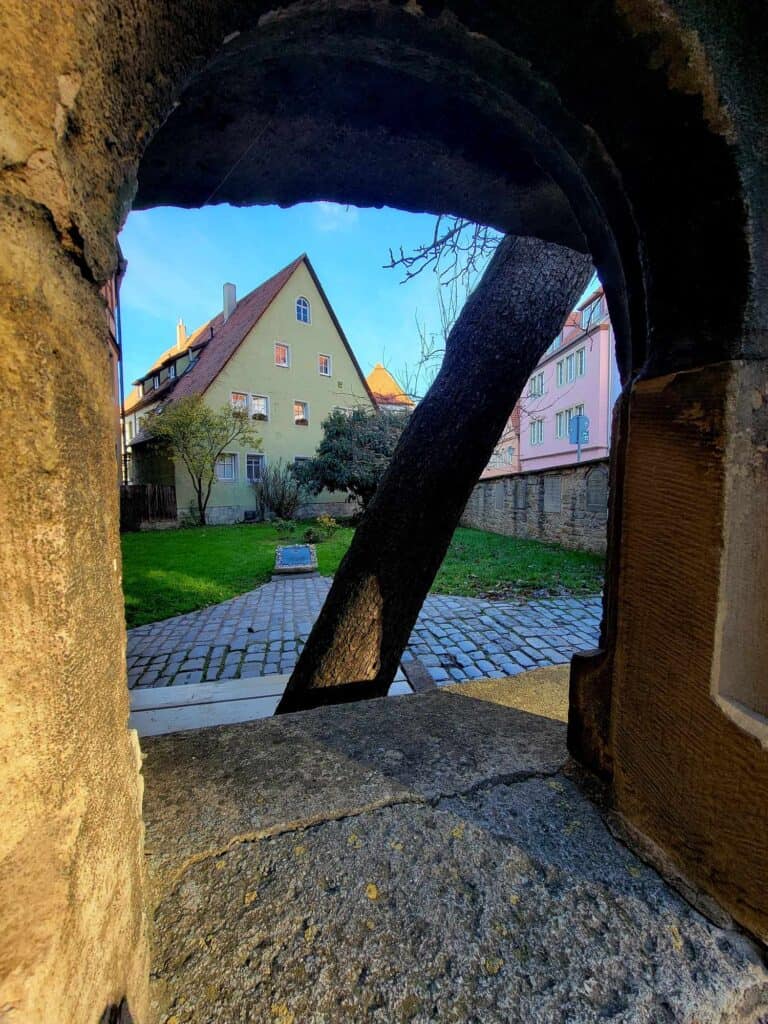
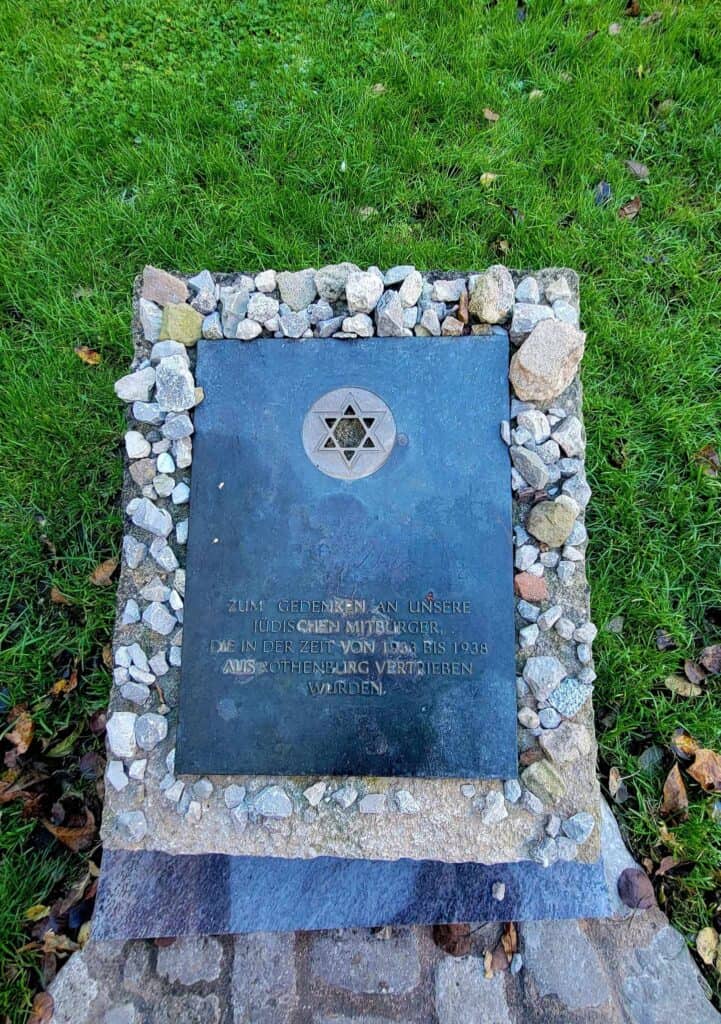
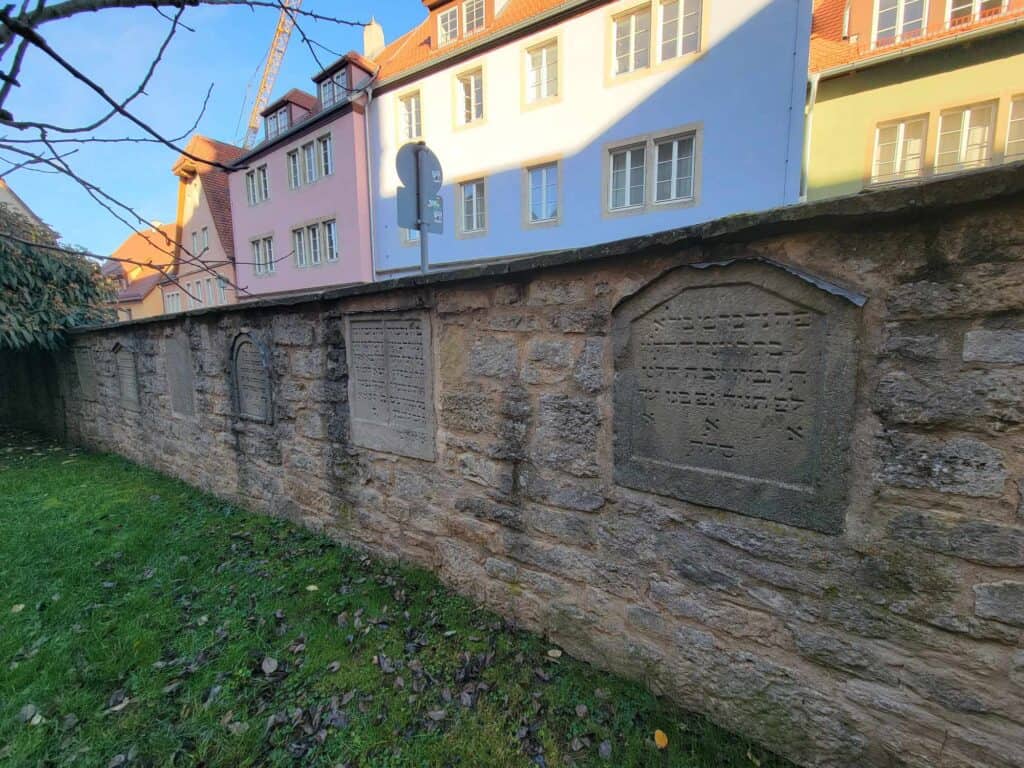
Meir of Rothenburg was an important Rabbi and poet who was abducted and imprisoned while trying to leave Germany in the 13th century. He died in prison after 7 years, and his body was later ransomed for burial in Worms, Germany, where he was born. This beautiful walled memorial garden features some of the old medieval Jewish tombstones which were discovered in 1914 on the grounds of the destroyed cemetery, and a plaque commemorating Rothenburg’s Jewish population who were deported to concentration camps. Most did not survive.
8) Judengasse
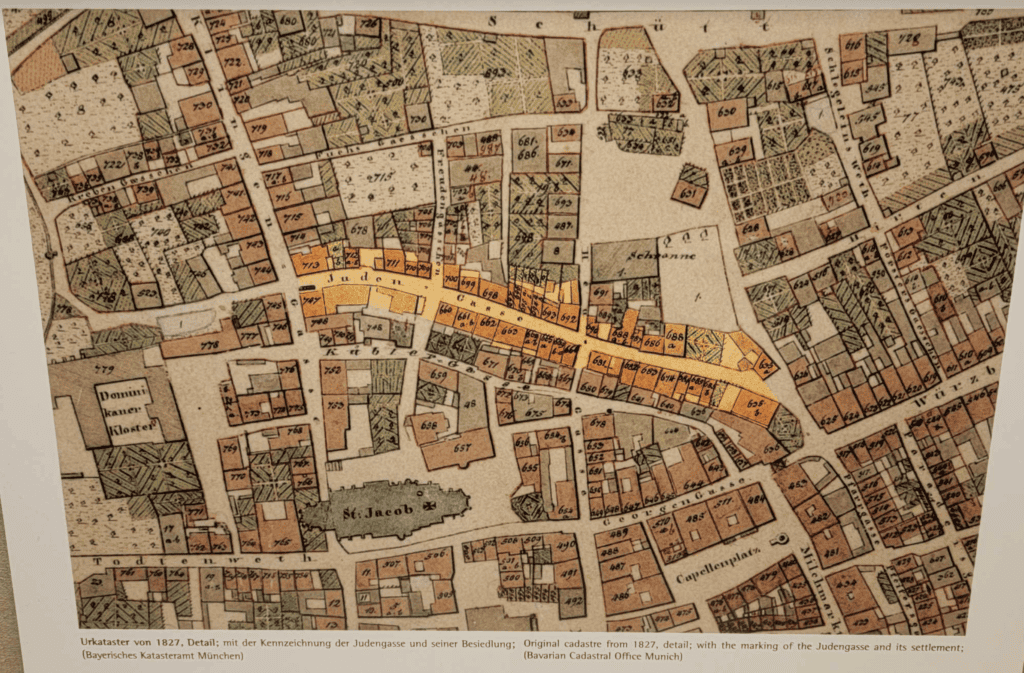
Judengasse, or “Jewish Alley” would have been the residential, cultural, religious, and educational center of Jewish life in the middle ages in Rothenburg. It is the only preserved late medieval Jewish alley in Europe.
Visit Judengasse 22 to see the stolperstein (stumbling stone) embedded in the cobblestones, honoring Jewish residents who were victims of the Holocaust.
9) Judengasse 27
While you are exploring Judengasse, you’ll find an unassuming house which is notable for being a temporary residence of Pope Francis during his studies in Rothenburg.
Climb, Walk, and Discover Iconic Spots
10) Walk Rothenburg’s Medieval Walls
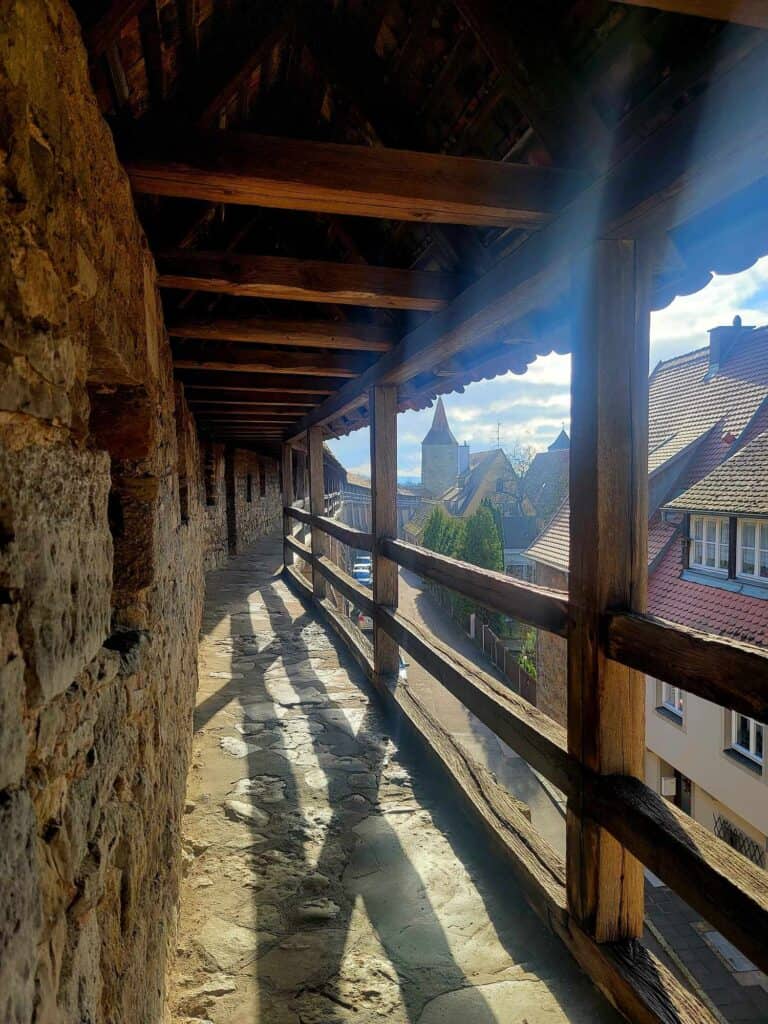
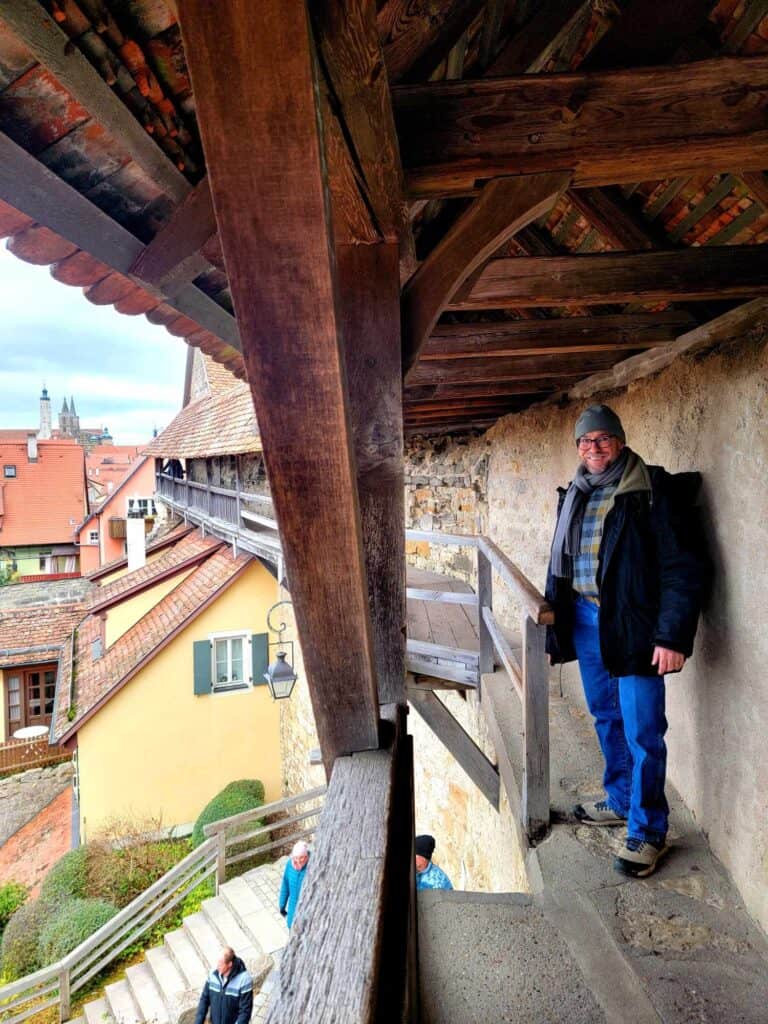
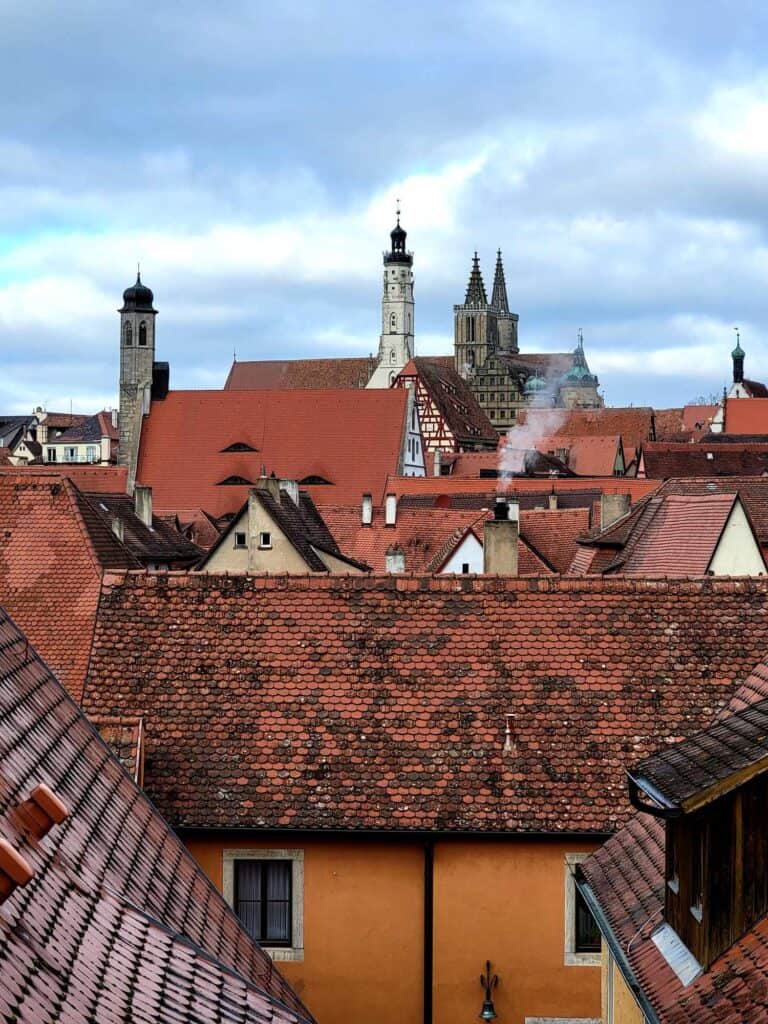
Rothenburg ob der Tauber is one of the best-preserved walled cities in Europe, with its original fortifications remaining largely intact since the Middle Ages! This was one of my favorite things to do in Rothenburg and really should be on your must-do list.
The walls stretch for about 2.5 miles (4 kilometers) but you don’t have to walk the whole thing if it seems too much. There are many places with stairs leading up to, and down from, the covered walkway. So you can walk as long as you like checking out the guard towers, arrow slits, and covered walkways.
The only damage to the walls occurred when they were breached by Catholic forces during the religiously motivated 30-years War, and then again during World War II.
11) Find the Wall Restoration Plaques
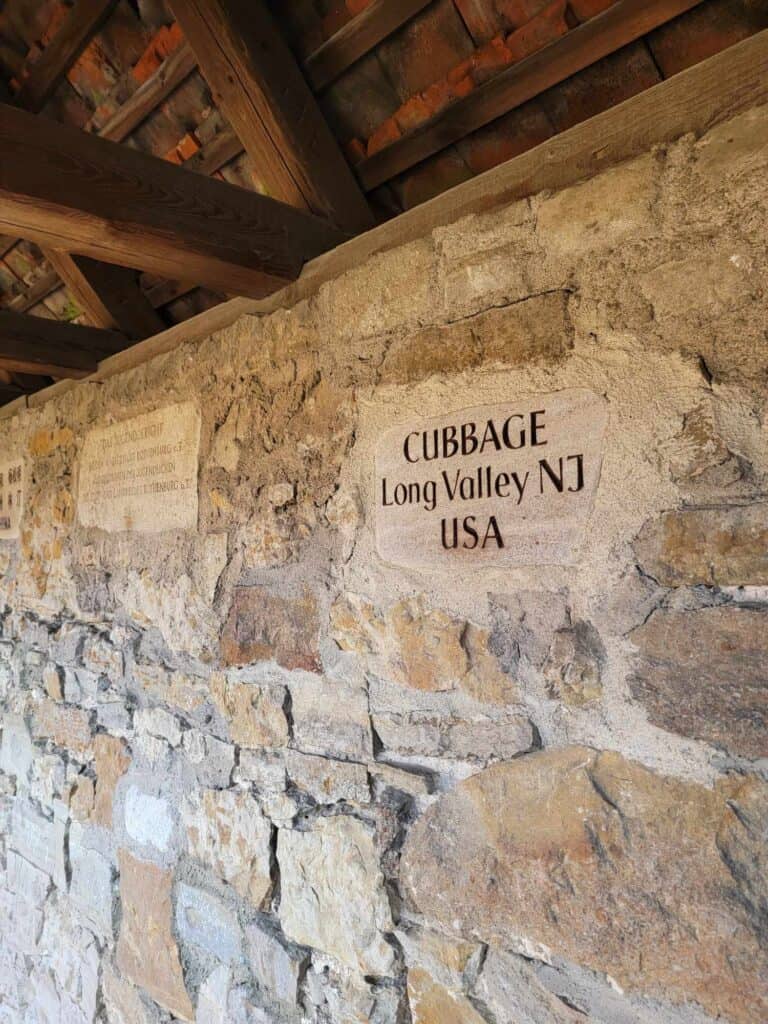
After World War II, international efforts helped rebuild the damaged sections of Rothenburg’s city walls, and you can see engraved plaques honoring the donors who helped to fund the project, and showing how many meters of wall they had funded. I thought this added an interesting layer of history to this already fascinating place, and I was amazed at how far and wide the donors came from. If you want to see the plaques, check out the area near the Klingentor and Rödertor sections of the walls which is where the damage occurred.
12) Climb the Röderturm
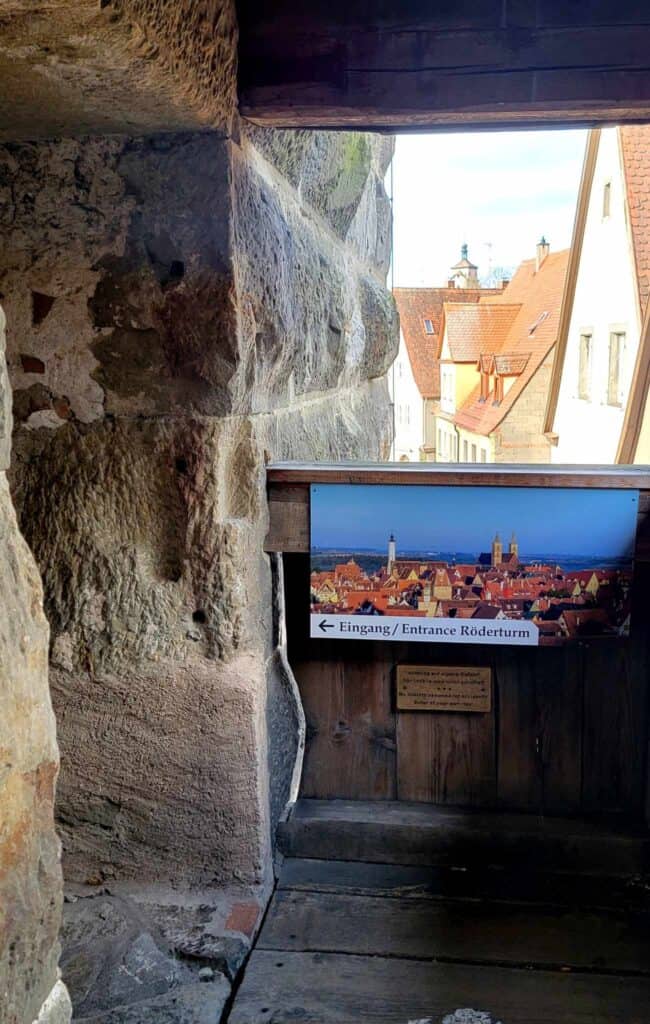
Check out the incredible views from the Röderturm (tower) if it’s access door from the wall is open. This will provide the best bird’s-eye view of the city, and give you some great photo opportunities. You can never tell when the tower will be open, though, so it’s the luck of the draw.
Only a few cities in Germany still have their fully intact medieval walls. They help to give Rothenburg that special magic, and provide a unique perspective on the town! And they are free to walk and explore!
You will need to climb a flight of uneven stone stairs, and the walk itself is often uneven with stone pavers, so wear comfortable shoes and be aware.
13) Get the Plönlein Photo
This is it! The iconic photo of Rothenburg ob der Tauber. The Plönlein, with its iconic half-timbered house and forked cobblestone street is probably the most photographed spot in Rothenburg.
This one is all about timing if you want to take a picture. It looks best in the morning or evening light-wise, but you’ll also be navigating around a bajillion other people who either want the same photo from closer up, or are completely oblivious they’re stopping to have a chat right in the middle of your shot.
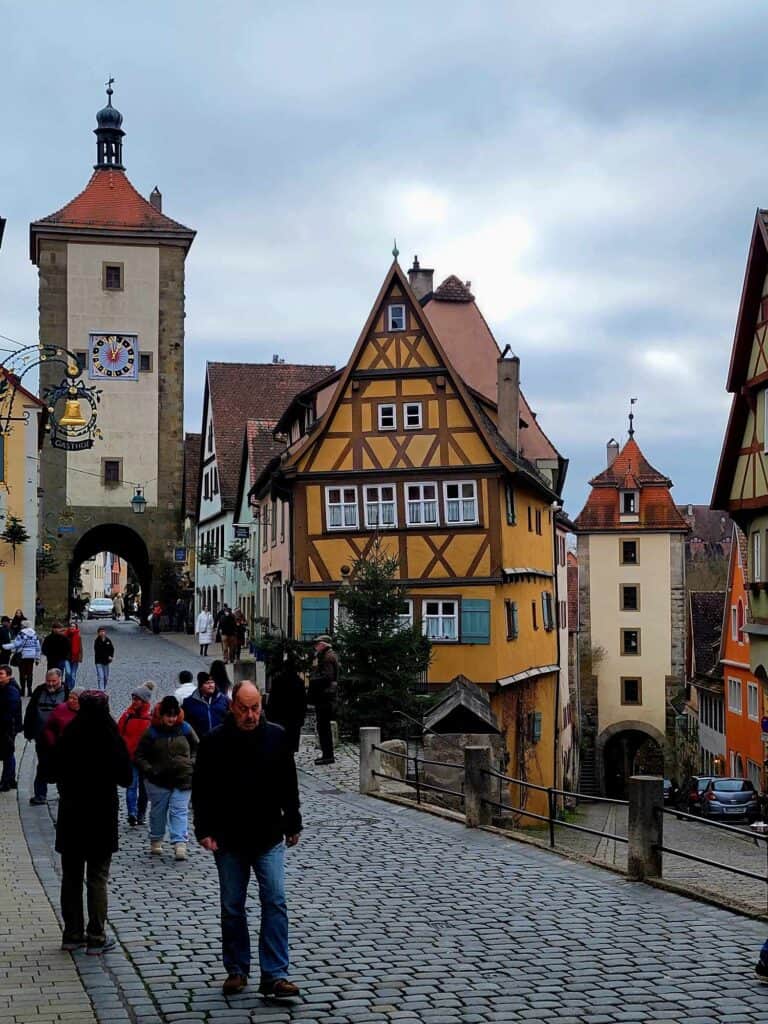
Just do the best you can, and maybe plan on walking by more than once if you are determined to catch the perfect postcard shot.
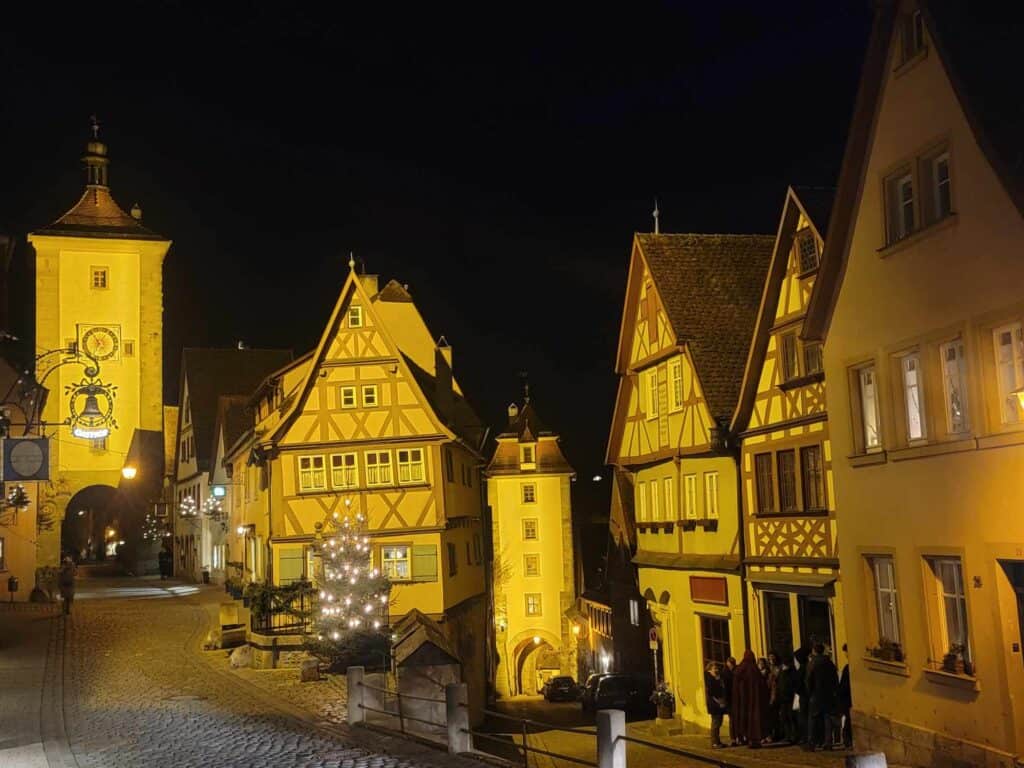
If you don’t, there are loads of places selling perfect photos, paintings, drawings, and every other representation you can think of.
14) Market Square and Town Hall Tower
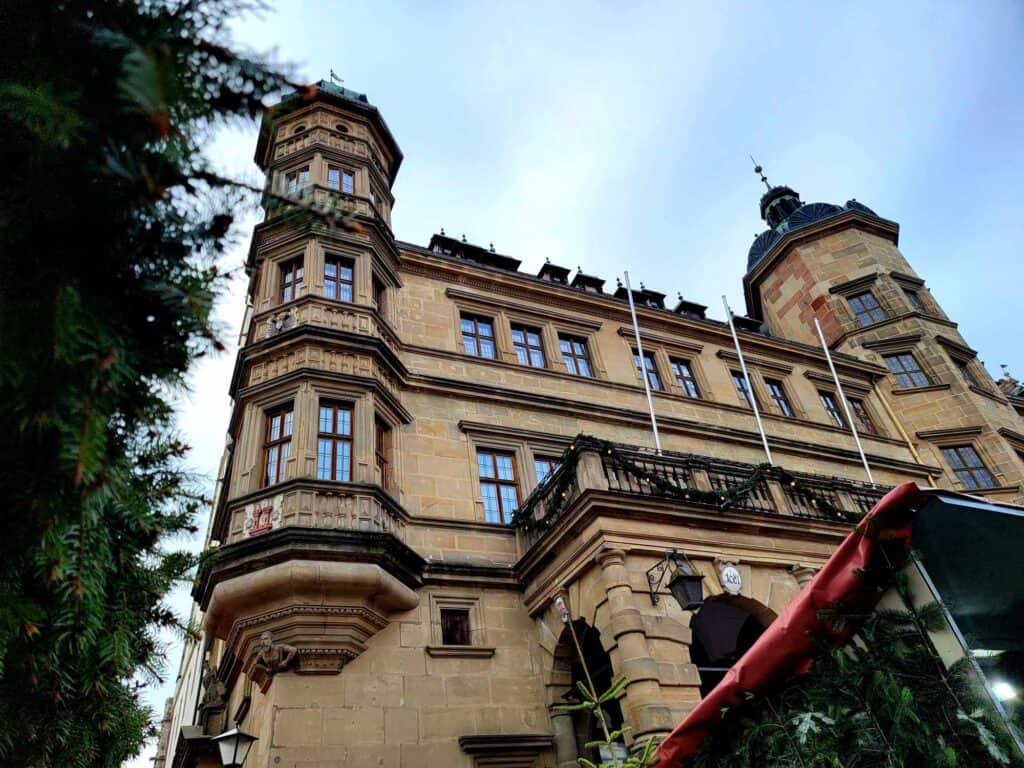
The Market Square (Marktplatz) is the heart of the Old Town in Rothenburg.
There are plenty of photo opps here, and you’ll want to just spend a little time wandering around, checking out the shops, stopping in a cafe, checking out the gothic-style fountain, and and people watching.
If you’re feeling more energetic, you can climb the tower in the 13th century Town Hall! In addition to walking the walls, this is an excellent spot to enjoy some sweeping panoramic views of the city and surrounding Tauber Valley.
15) Baumeisterhaus (Master Builder’s House)
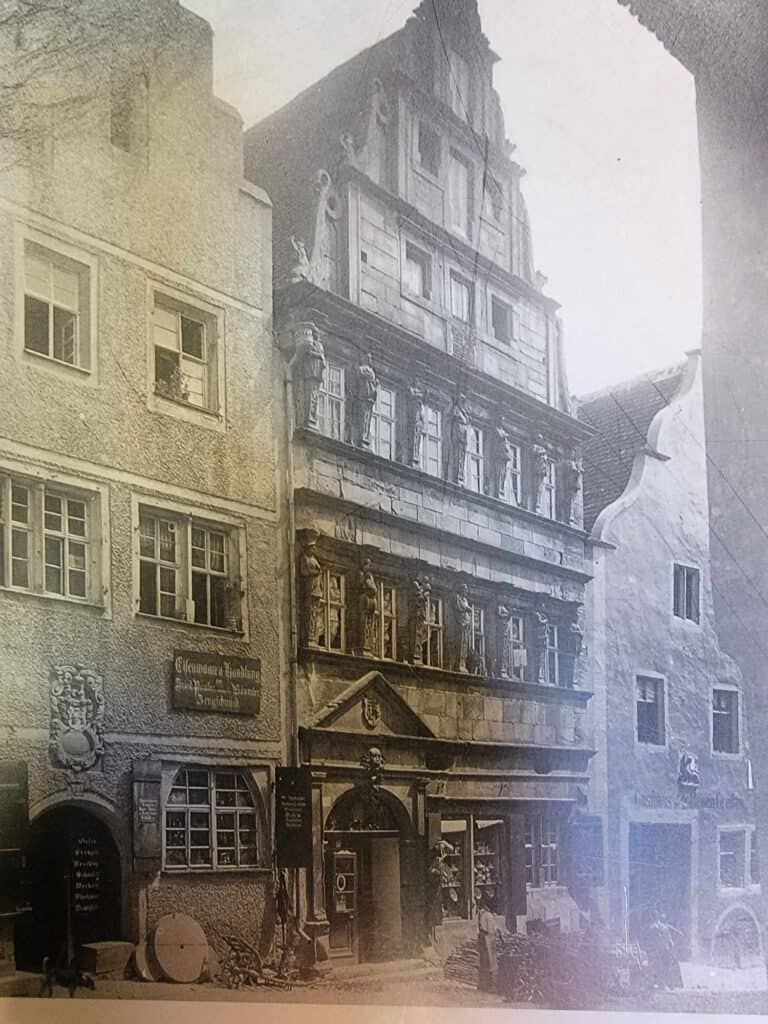
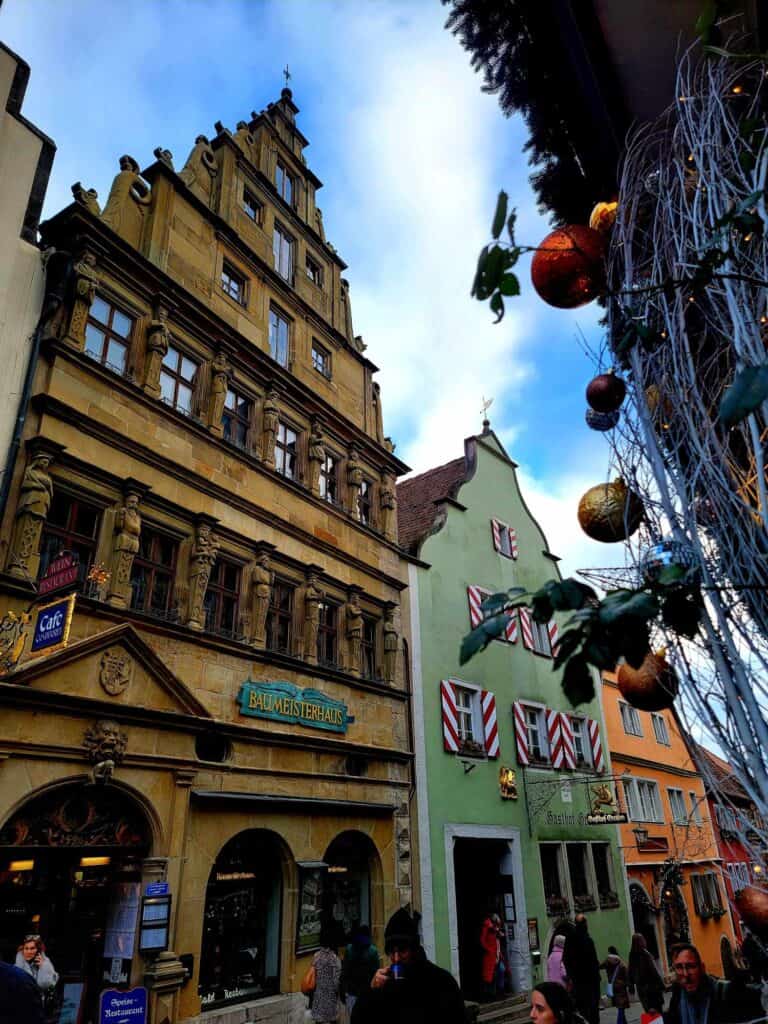
The Baumeisterhaus, or Master Builder’s House, was built in 1596 by the famous city architect Leonhard Weidmannand, and it features a stunning and intricate facade covered with carvings and mythical creatures. They represent the 7 deadly sins and the 7 cardinal virtues! It’s fun trying to tell what’s what since they are all mixed together.
Once the home of a wealthy merchant, it’s a window into Rothenburg during the Renaissance. Today it’s also a small but busy restaurant and guest house, where you can enjoy local Franconian specialties or coffee and cake.
16) Graphic Museum in the Dürerhaus
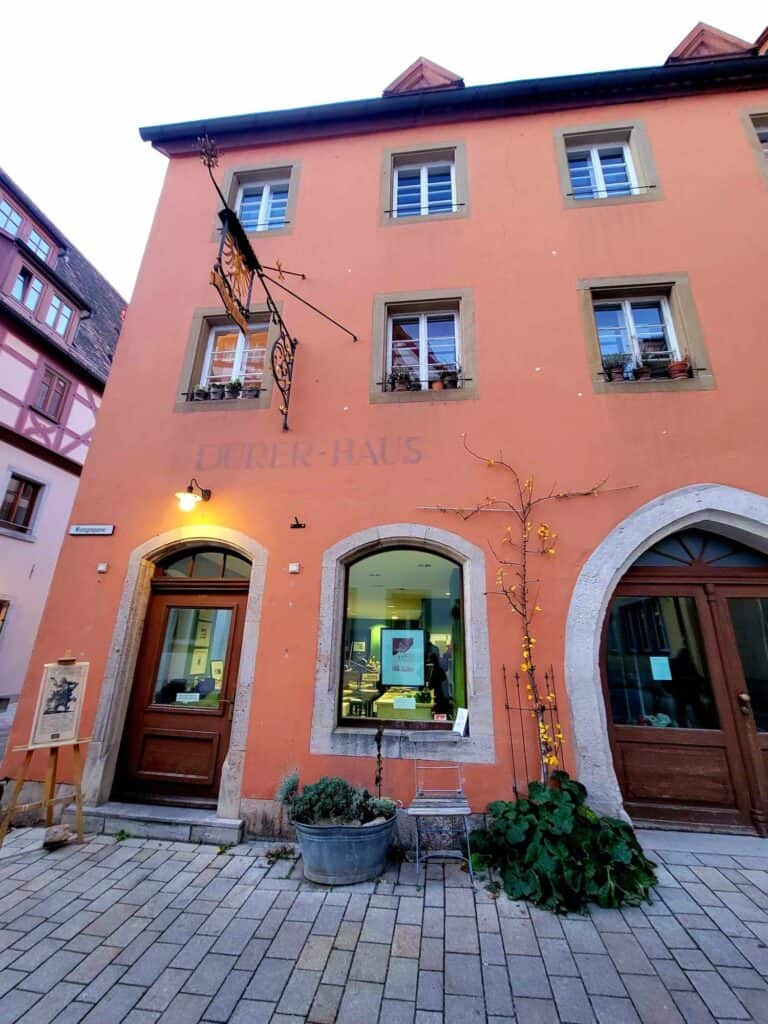
This tiny private museum is a powerhouse of incredible art! You can see original etchings by Albrecht Dürer (arguably Germany’s most renowned artist), Rembrandt, Goya, and more. They have all been collected by the artist Ingo Domdey over the course of many years. There’s also a printing workshop where you can try out the engraving techniques yourself.
Tours and Festivals
17) Night Watchman Tour
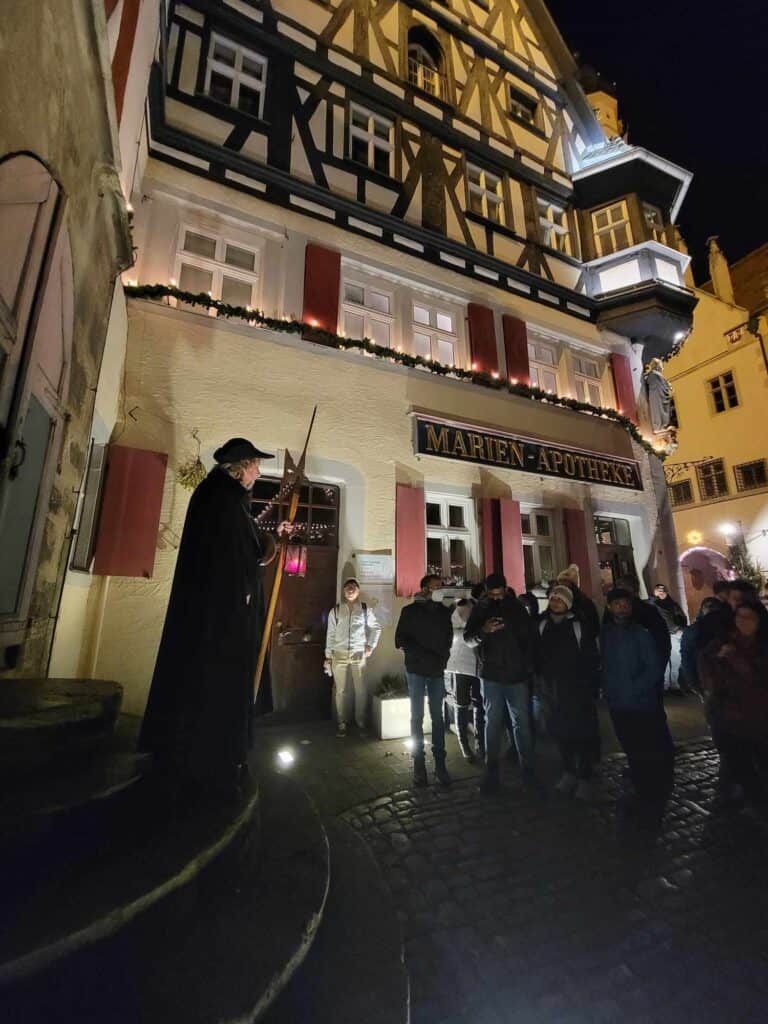
If you are spending the night in Rothenburg the famous Night Watchman tour should be on the top of your list! Meet up at 8:00pm in the Marktplatz by the Town Hall. There are tours both in English and German.
The tour lasts for about an hour an is well worth the €9,50 for adults (kids are free). You’ll get a lively and entertaining tour of Medieval Rothenburg and its fascinating history from a cloaked, lantern-carrying night watchman whose name is Hans Georg Baumgartner.
Herr Baumgartner has been doing this for decades, and is a beloved Rothenburg institution! There’s no need to make a reservation, just show up and join the group. Payment is cash only, and at the end of the tour. Check out the Night Watchman’s official website for more details.
If you prefer your own individual Night Watchman Tour, that’s possible too!
Sponsored content: This section contains affiliate links
18) Take a City Tour
And while the Night Watchman tour is great to get an overall idea of the city history, a full-on guided city tour will cover many more locations and provide deeper insights into Rothenburg’s architecture, legends, and history. The best part to me about guided tours are all the stops at those hidden gems not easily found on your own.
You can find anything from a basic go-at-your-own-pace audio tour, to a completely private history guide for up to 20 people!
✅ Take a full-day guided tour from Frankfurt to Rothenburg or Munich to Rothenburg!
19) Master Draught Festival
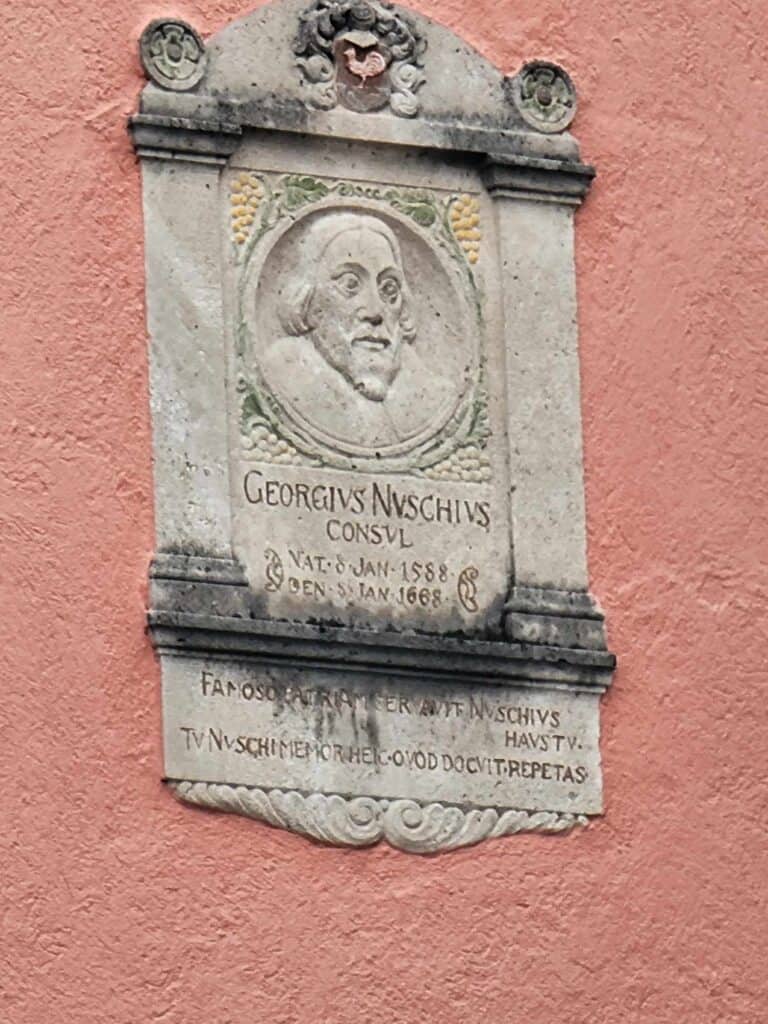
The Master Draught Festival (Meistertrunk) reenacts a legendary event from the Thirty Years’ War, in which Rothenburg saved itself from a seige. The legend says that the head of the Catholic Army General Tilly proposed a challenge. He would spare Rothenburg and call off the seige if they could find someone to drink a gigantic and unweiedy tankard of wine… in one gulp.
Enter Mayor (Meister) Georg Nusch who volunteered to undertake the task. In view of the army, the mayor polished off the entire thing in one continuous gulp. Tilly was so impressed, he kept his promise and called off the seige. And the town was saved!
Whether this is actually true or not is up for debate, but regardless the story has become part of Rothenburgs lore and identity.
So during the Meistertrunk festival you can enjoy parades, theatrical performances, and period costumes. And of course, your own tankard of wine if you like! Most of the festivities happen in or near the Marktplatz.
Find the Towers and Gates!
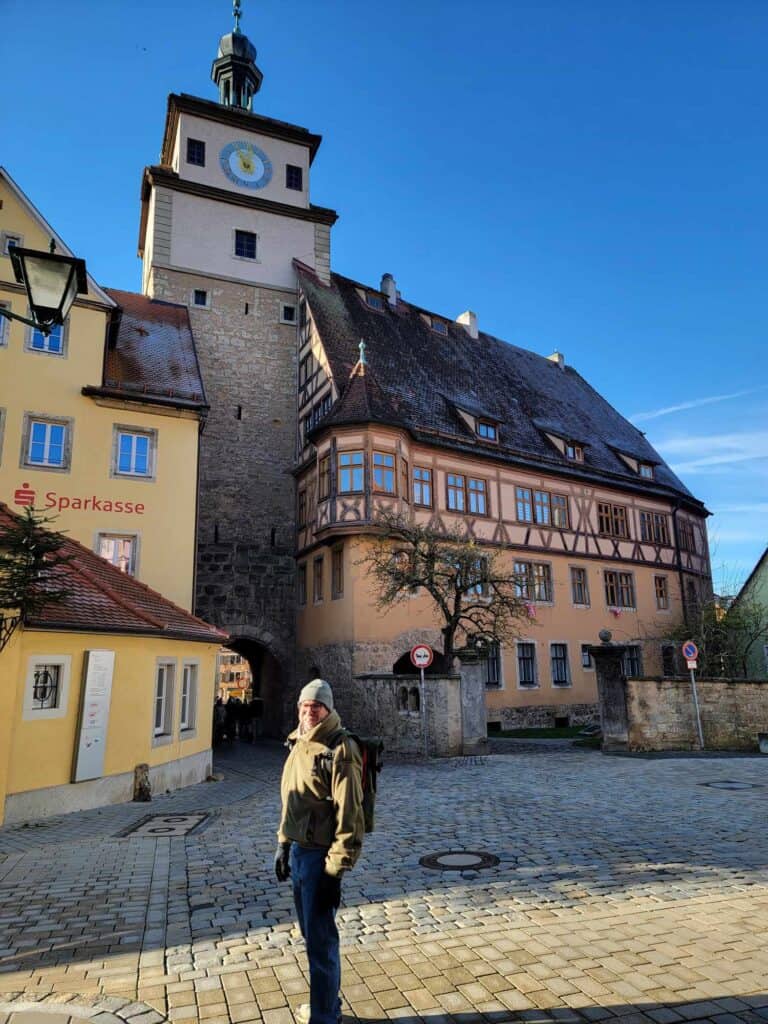
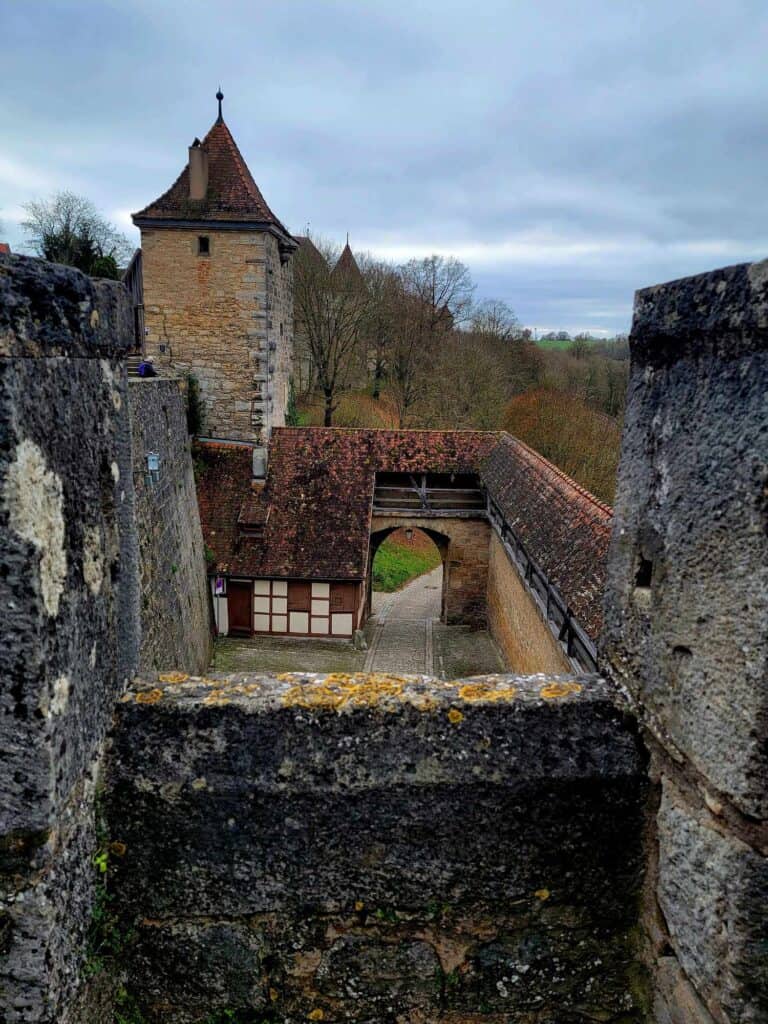
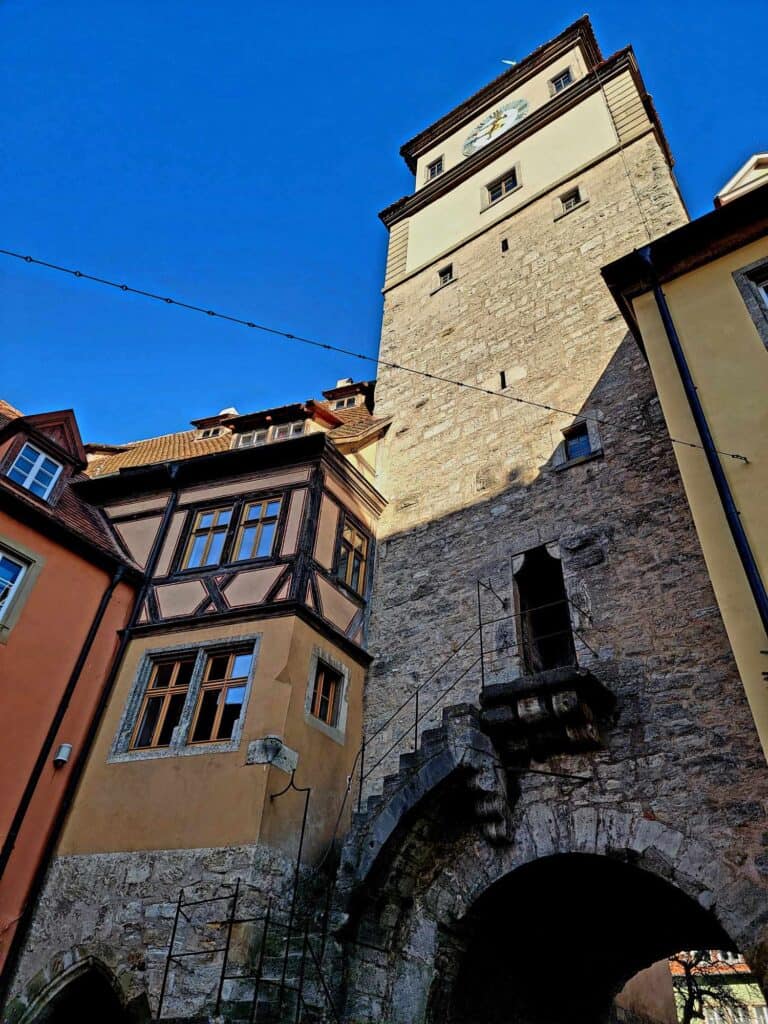
Rothenburg is chock full of amazing and beautiful towers. Some are connected to the fortification walls, and others are not. But it feels like everywhere you look there’s another one to explore.
20) Galgentor (Gallows Gate) / Würzburger Tor
Located on the northern side, its name, Galgentor (Gallows Gate), refers to the fact that the town’s execution site was just outside this gate.
21) Klingentor
Built in the late 14th century, Klingentor has a water tower that supplied the water for the town’s fountains! It was once part of a defensive system and is one of the most imposing towers in Rothenburg. You can climb this one for views!
22) Burgtor (Castle Gate)
This fortified gate used to be the entrance to the Hohenstaufen Imperial Castle, but sadly an earthquake destroyed the castle in 1356. The Burgtor was then turned into a defensive structure and still has a relief of a double-headed imperial eagle above its entrance.
23) Kobolzeller Tor
This one is at the southern entrance to the city, and dates back to the late 14th century. It was used to access the Tauber River and important trade routes.
24) Spitaltor (Spital Gate)
This gigantic gate was designed by military engineer Leonhard Weidmann and built in 1586. It features an inscription reading “Pax intrantibus, salus exeuntibus” meaning “peace to those who enter, health to those who leave.” Built in 1586, this imposing bastion is the last great expansion of the city’s defenses. It features an eight-gate system for extra security!
25) Siebersturm (Siebers Tower)
Plönlein 14
This charming tower, dating from around 1385, is part of the Plönlein, Rothenburg’s most photographed spot.
26) Markusturm
Rödergasse 1
Markusturm is one of Rothenburg’s oldest towers, dating back to the 12th century when the town was first fortified. The tower originally formed part of the earliest city wall before Rothenburg expanded.
27) White Tower (Weißer Turm)
Georgengasse 17
This 12th-century tower is also one of Rothenburg’s oldest surviving structures and was originally part of the first city wall before the town expanded. It stands near the Ludwig-Straße and marks the former entrance to the Jewish Quarter, where the first synagogue once stood.
28) Hegereiter (Hegereiter Tower)
Spitalhof 2
This half-timbered tower house is located near the Spital Gate and was once the residence of the Hegereiter (gamekeeper) of the Spital district.
29) Stöberleinsturm (Stöberlein Tower)
Named after a former Rothenburg family, this smaller tower is part of the town’s outer fortifications. It’s one of the many watchtowers that allowed guards the vantage point to monitor the surrounding countryside for potential threats.
30) Topplerschlösschen (Toppler’s Little Castle)
While technically not a fortification tower, this small defensive residence was built in 1388 by Mayor Heinrich Toppler, one of Rothenburg’s most famous leaders. It’s cute and charming, and sits along the Tauber River, outside the main town walls. It served as both a summer retreat and defensive stronghold.
31) Pulverturm (Powder Tower)
This tower was used to store gunpowder and other military supplies for the town’s defenses. It is located along the city wall, where it played a critical role in Rothenburg’s ability to defend itself during sieges.
32) Luginsland (Look-Into-the-Land Tower)
Near Burgtor
As you would imagine from the name, this was a watchtower, built to provide a sweeping view of the Tauber Valley. It helped to guard Rothenburg’s western approach.
Indulge in Rothenburg’s Christmas Magic (all year long!)
33) Käthe Wohlfahrt Store and Christmas Village
Herrngasse 1, 91541 Rothenburg ob der Tauber
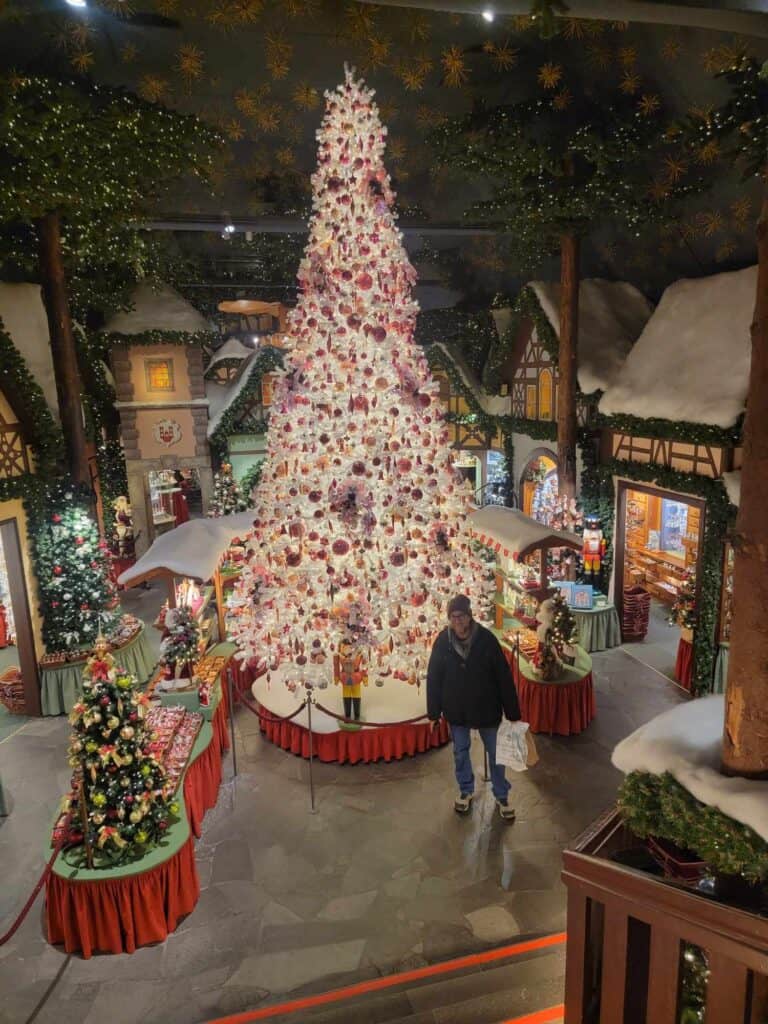
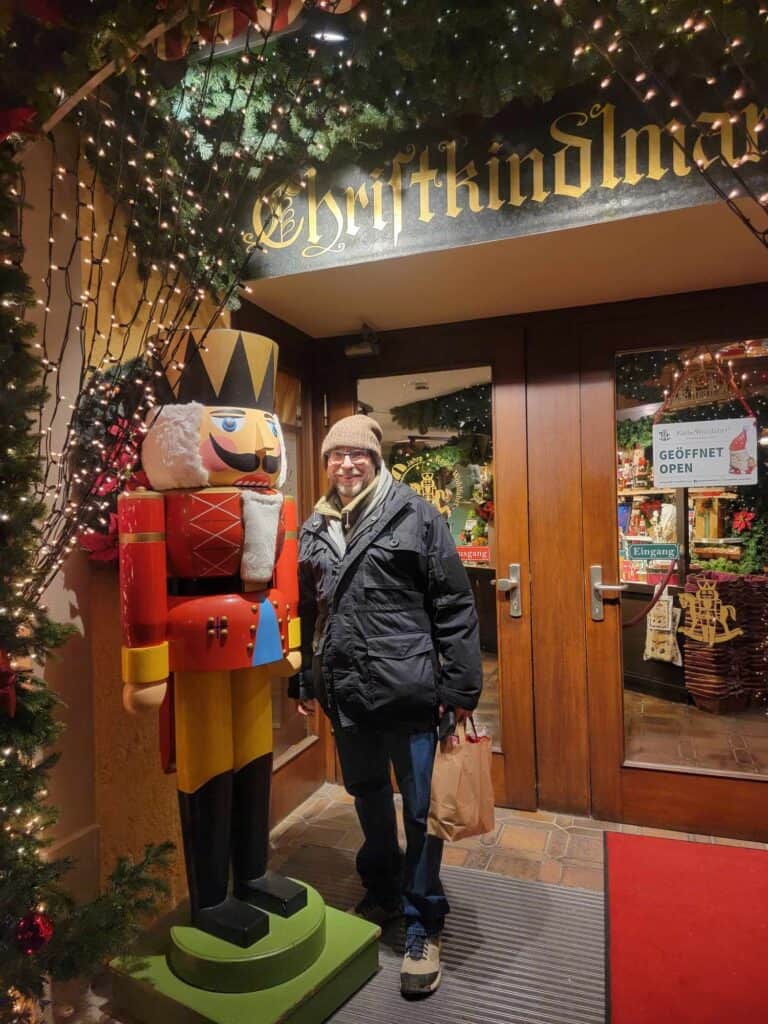
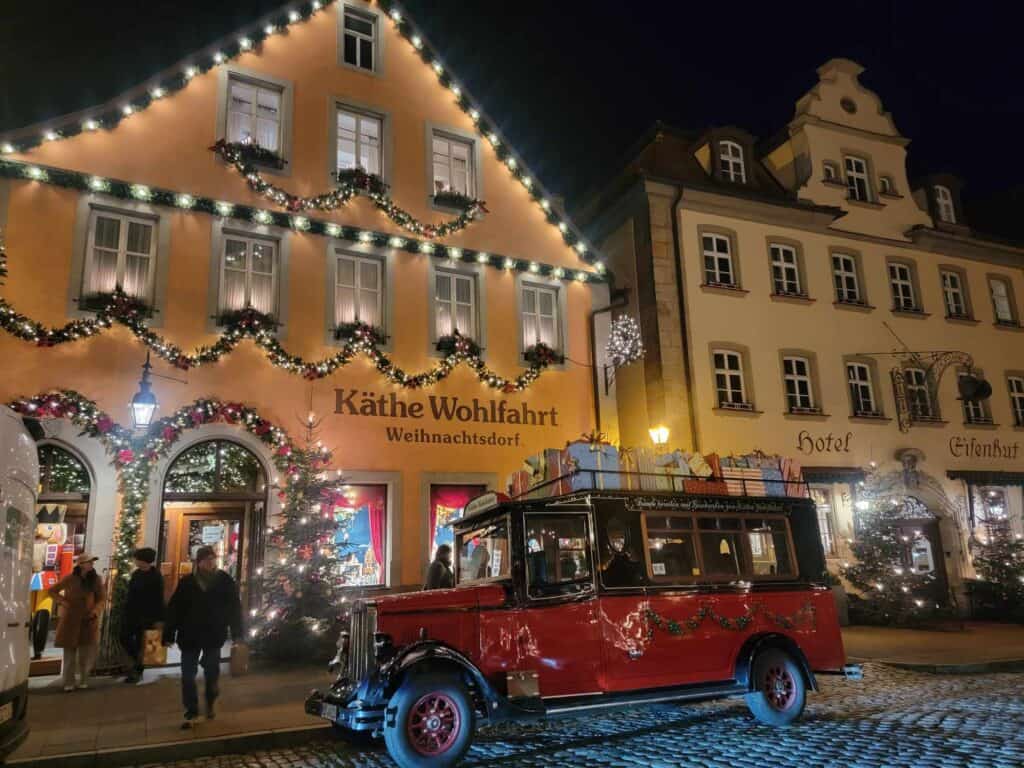
Rothenburg is the world headquarters of the famous Käthe Wohlfahrt store! It’a an absolute wonderland of ornaments, nutcrackers, German incense smokers, and Christmas decor, and it’s open all year! Everything inside is made in Germany, and it’s the perfect spot to pick up souvenirs or gifts to add some Central European charm to the holidays!
34) The German Christmas Museum
Herrngasse 1, 91541 Rothenburg ob der Tauber
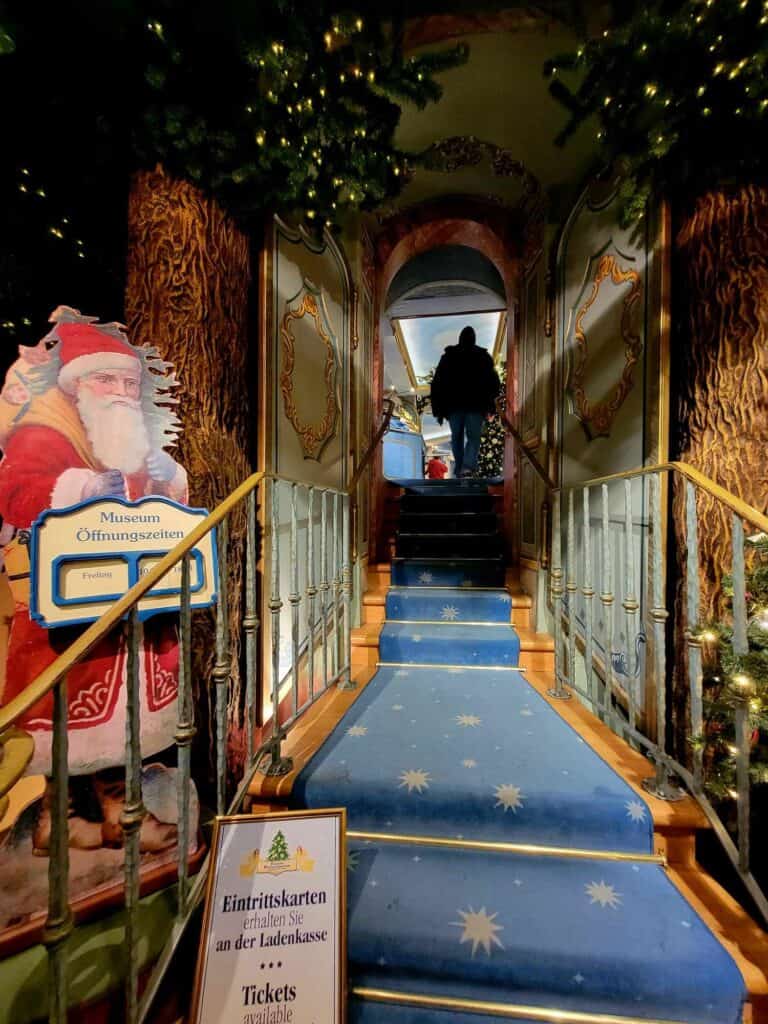
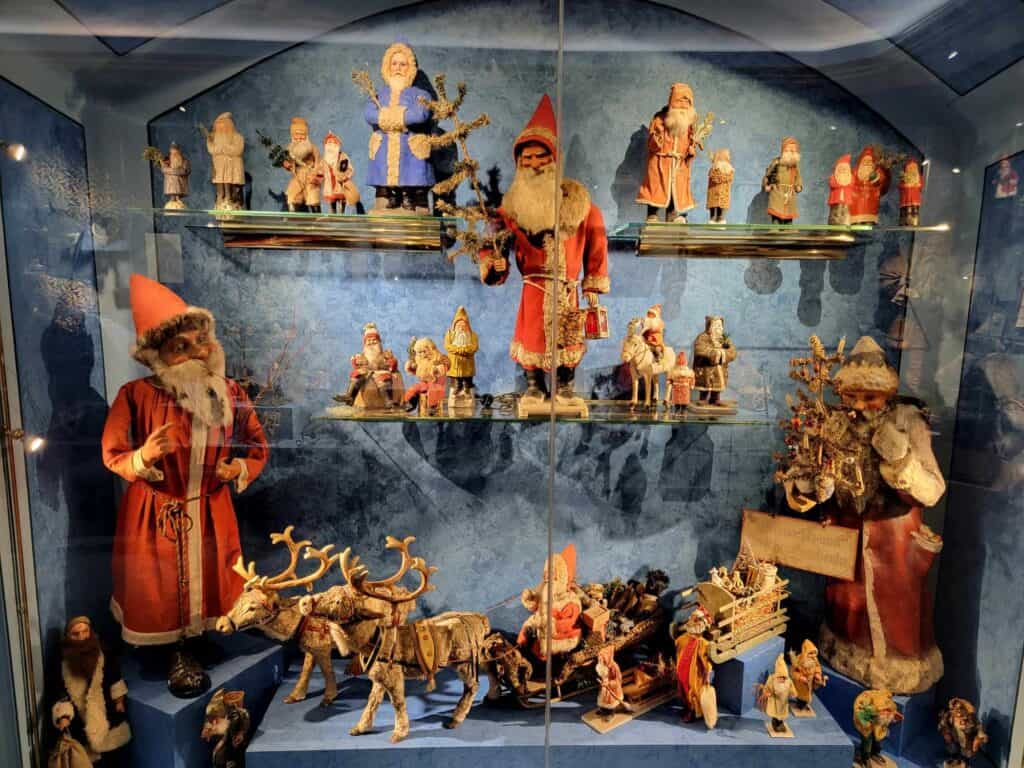
For an additional few euros you can head up the stairs and through a very magical-looking door to the German Christmas Museum! I wasn’t sure what to expect, but it was great! It showed displays of how Christmas trees evolved through the centuries, and had an incredible collection of ornaments from hand-made, to crafted, then the evolution of blown glass and molded glass.
For fans of Santa and his naughty cousin Krampus, you’ll find a whole display dedicated to them too. It was weird and fun and festive!
Allow about 30-45 minutes to go through the museum.
Note: Admission is €6 for adults and they only accept cash!
35) The Christmas Market
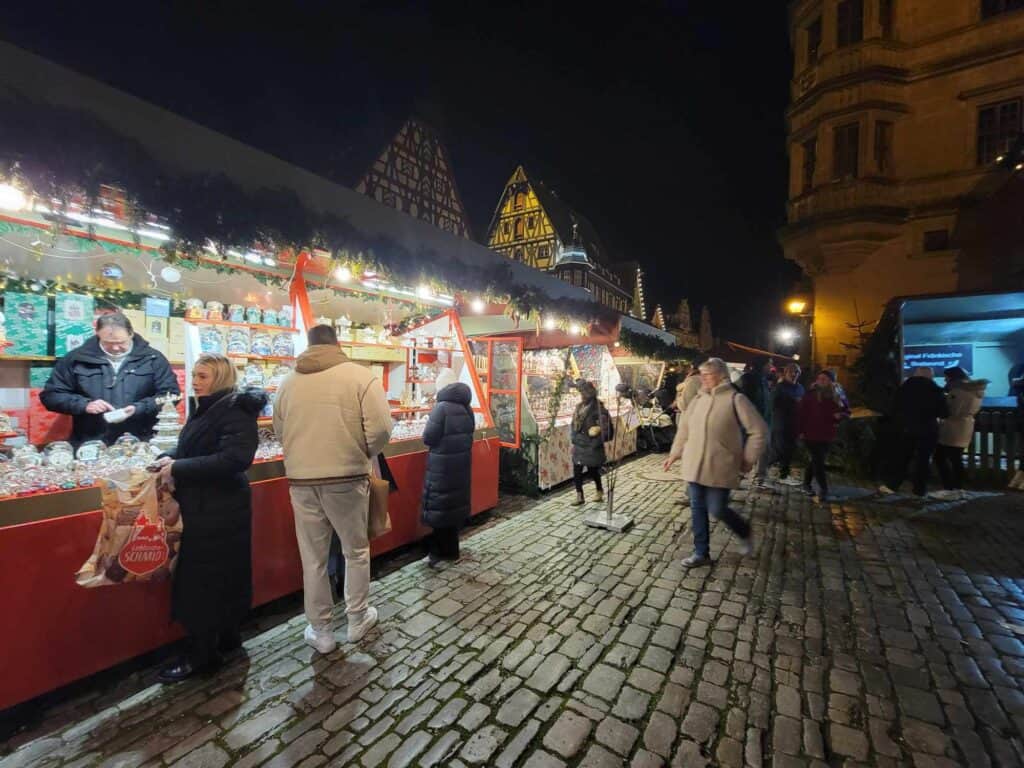
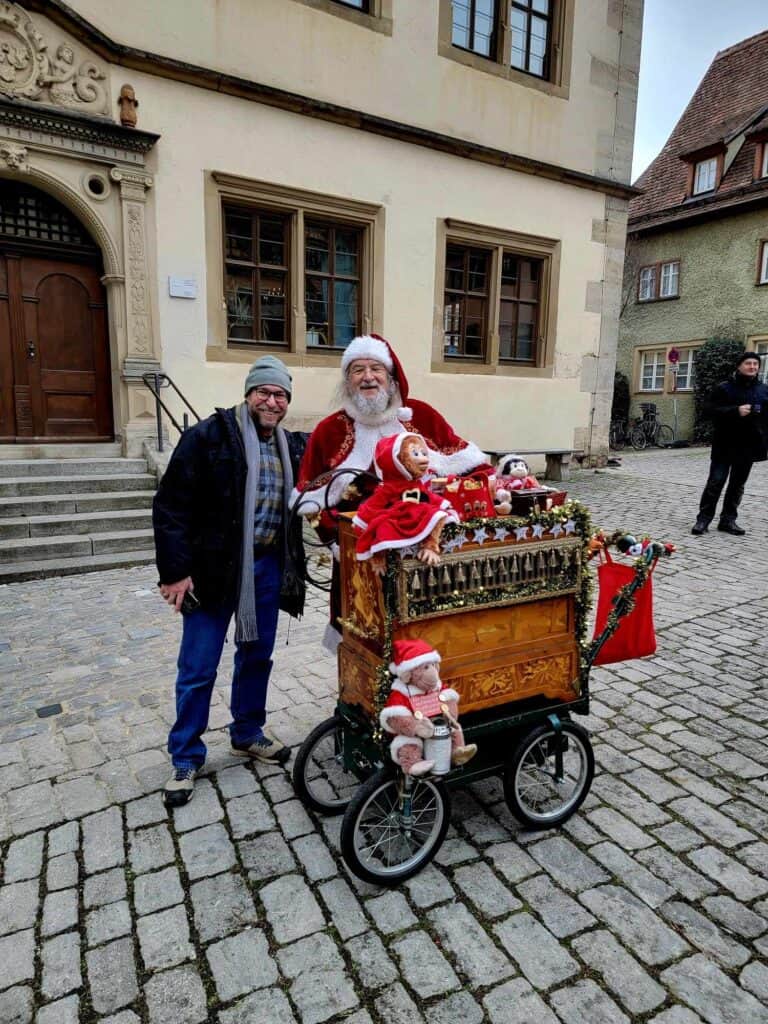
If you are in Rothenburg during the end of November to December 23rd, the Christmas Market will be in full swing! There’s a reason people from all over the world visit Rothenburg this time of year!
You can read all the details here:
Rothenburg ob der Tauber Christmas Market: Medieval Magic Awaits!
36) Eat a Schneeball

The Schneeball, or “snowball,” is a local pastry made from strips of dough which are crumpled up, deep-fried, and dusted with powdered sugar or a sweet glaze. Sometimes they’re sprinkled with nuts! Variations include chocolate, caramel, Irish cream, and marzipan.
I’ve heard some people say they’re too hard, but the secret is to dunk them in a hot drink like coffee, glühwein, or hot chocolate. Try one at any number of local bakeries and you can decide if it lives up to the hype!
Explore Amazing Shops
If you love window shopping, or in-store shopping at cute little gift stores, boutiques, and galleries, Rothenburg is for you! We went into so many shops it all became a blur! But even so, there were a few places which really stood out and we give them all a big thumbs up.
37) Hasi’s Laden
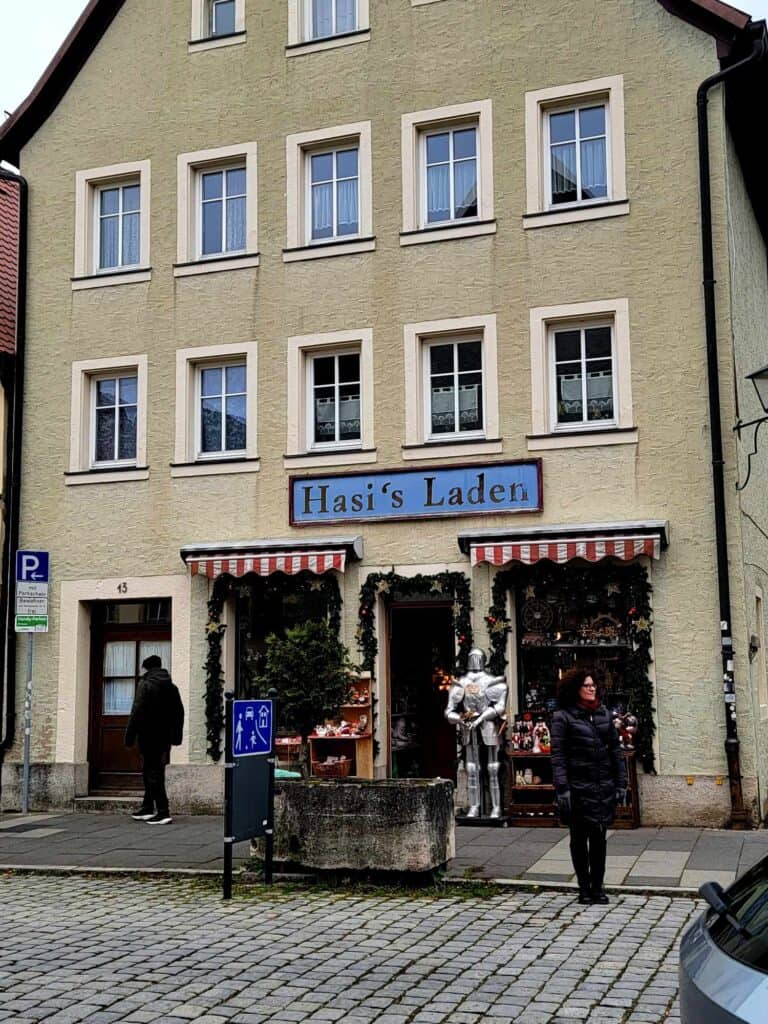
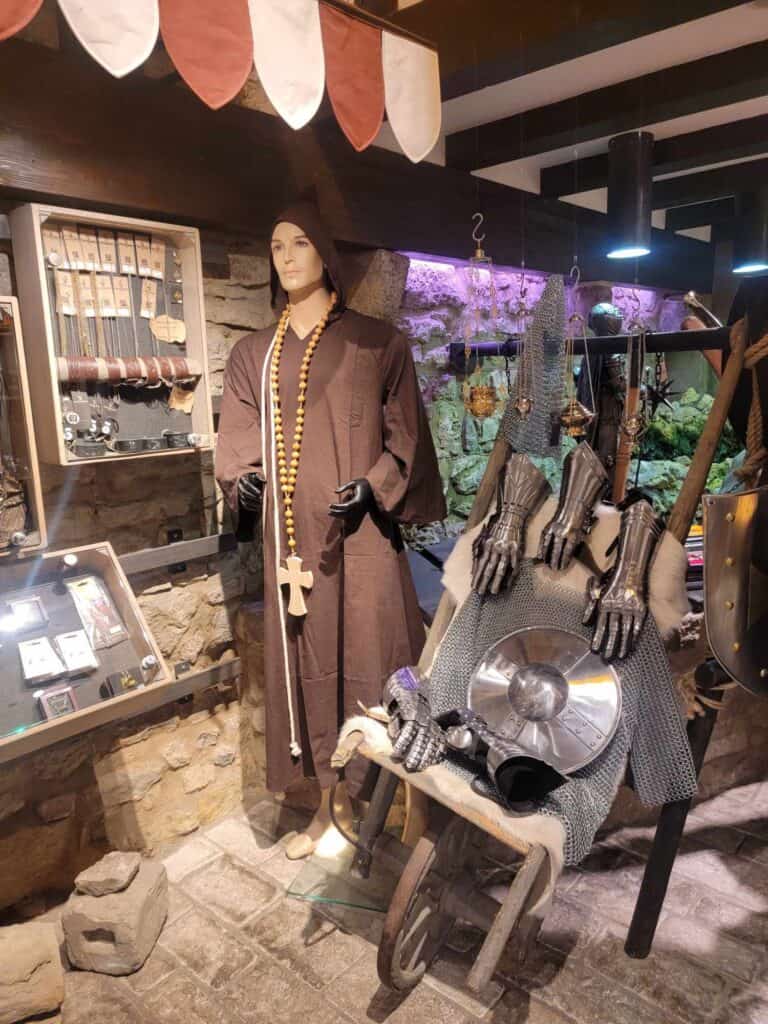
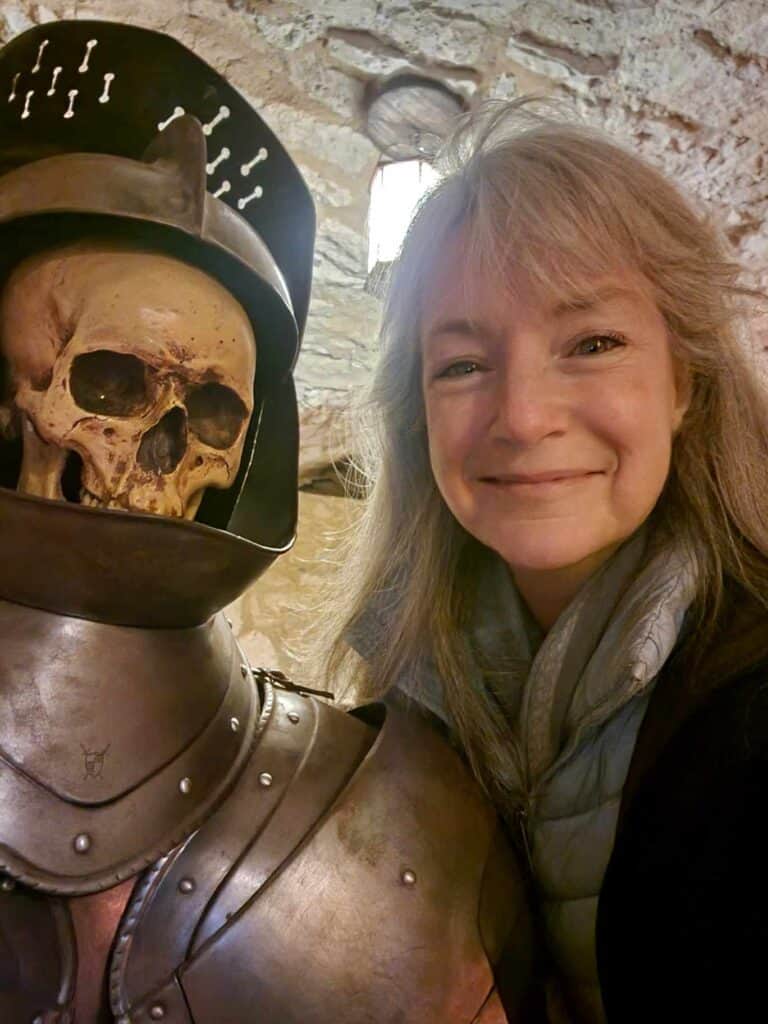
Definitely take some time to explore this one! If you are a fan of the medieval era, or just if Rothenburg has gotten you in the mood, you will love this place. It’s got all kinds of medieval costumes, decorative items, mead and absinthe, gifts, and more.
Downstairs there’s even a little tavern where I met the brave knight in the picture.
38) Alex Allegra Schokolade
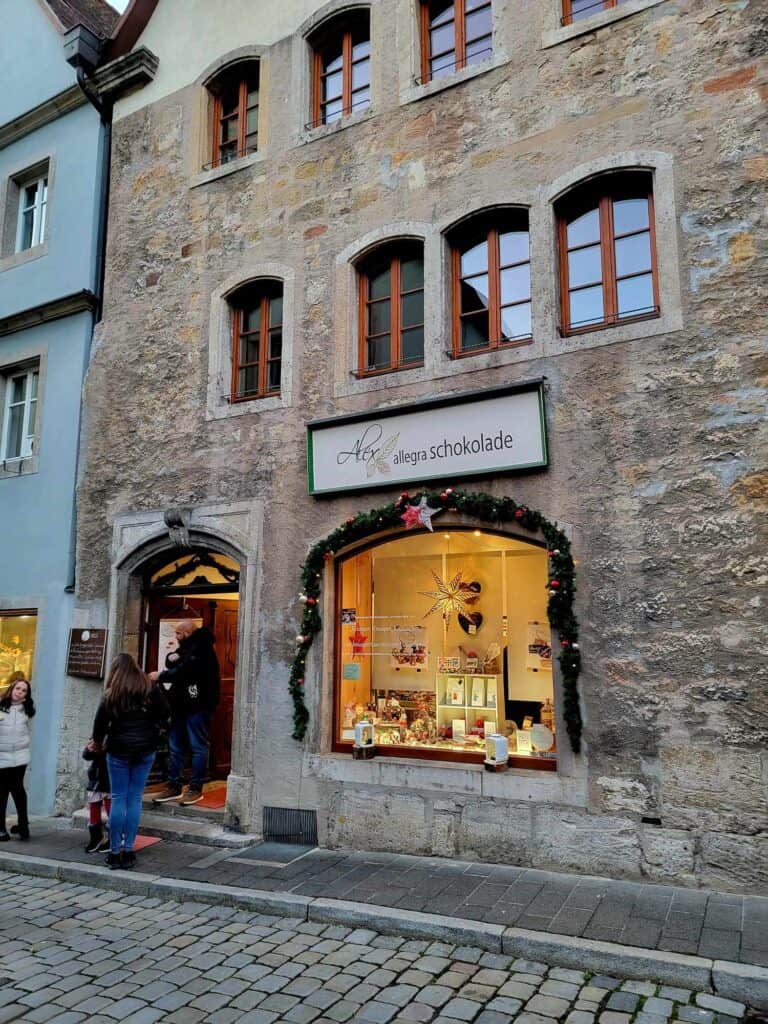
This little chocolate shop was the first place we stopped in Rothenburg, and the friendly owner gave us a map of the city, pointed us where we needed to go, and rang up a pretty big order of chocolate from us! We got gifts, but also indulged ourselves. Two thumbs up from us!
39) Röthenburger Steine Laden
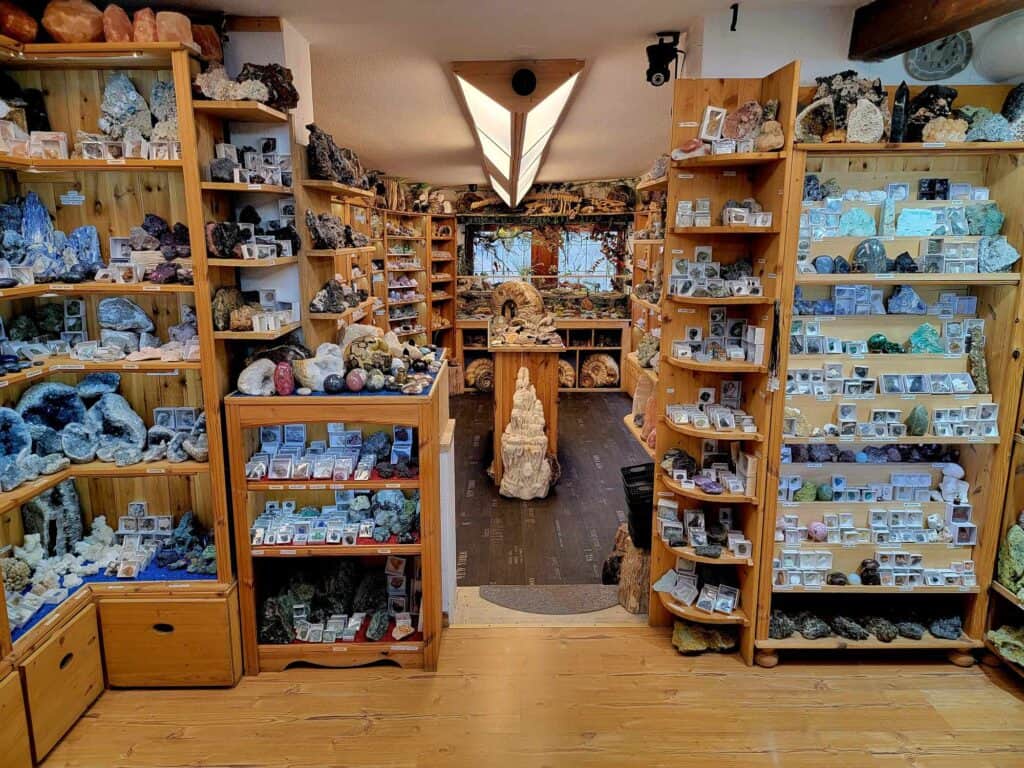
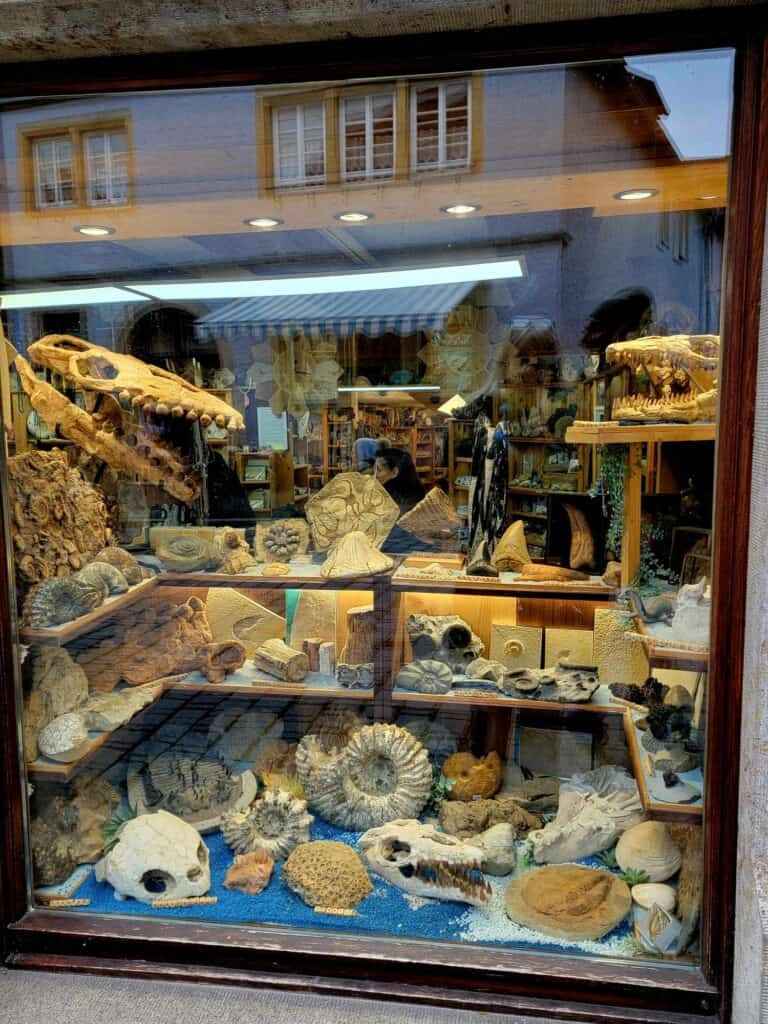
As a complete rock hound, this store was probably my absolute favorite in Rothenburg. I used to own a store that sold rocks and minerals, and I’ve been to all the big rock shows, and probably a million rock shops. Most shops all seem to have the same things, from the same deposits, that they buy en masse. Not here.
I found so many one-of-a-kind fossils, unusual minerals, and LOTS of local specimens. While drooling over these things I found out that the owner had collected much of the inventory herself over the years! If you are into this kind of thing, you’re going to have a field day here. Or this would make a great spot to pick up a gift for a collector.
40) Hafengasse 15
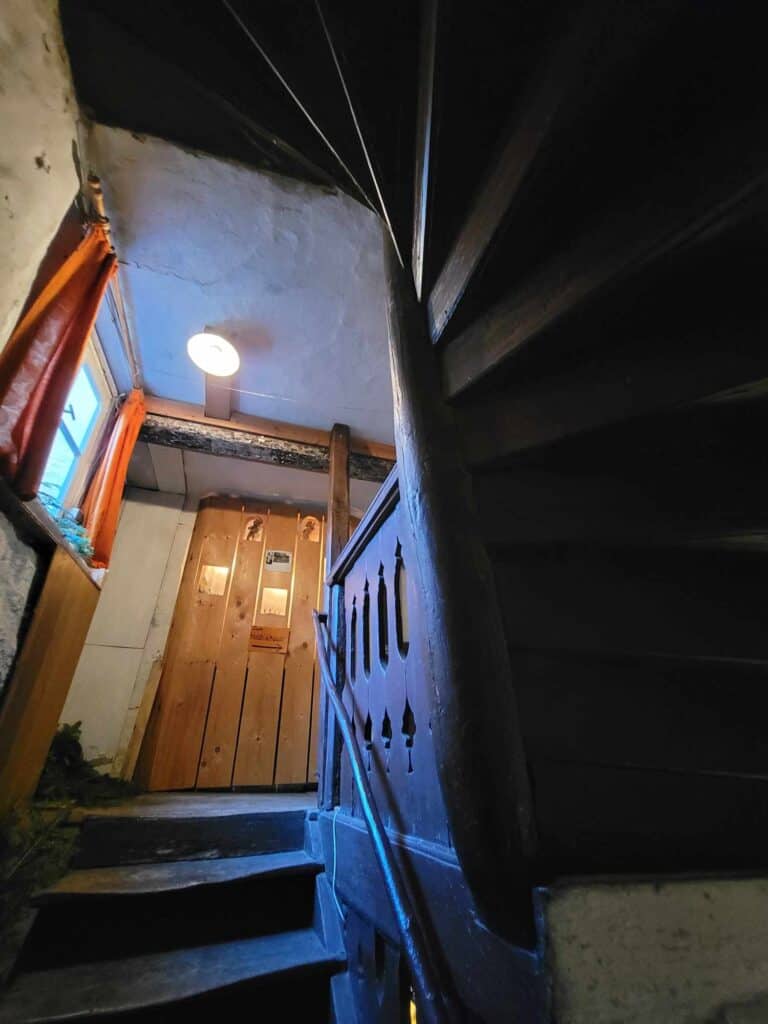
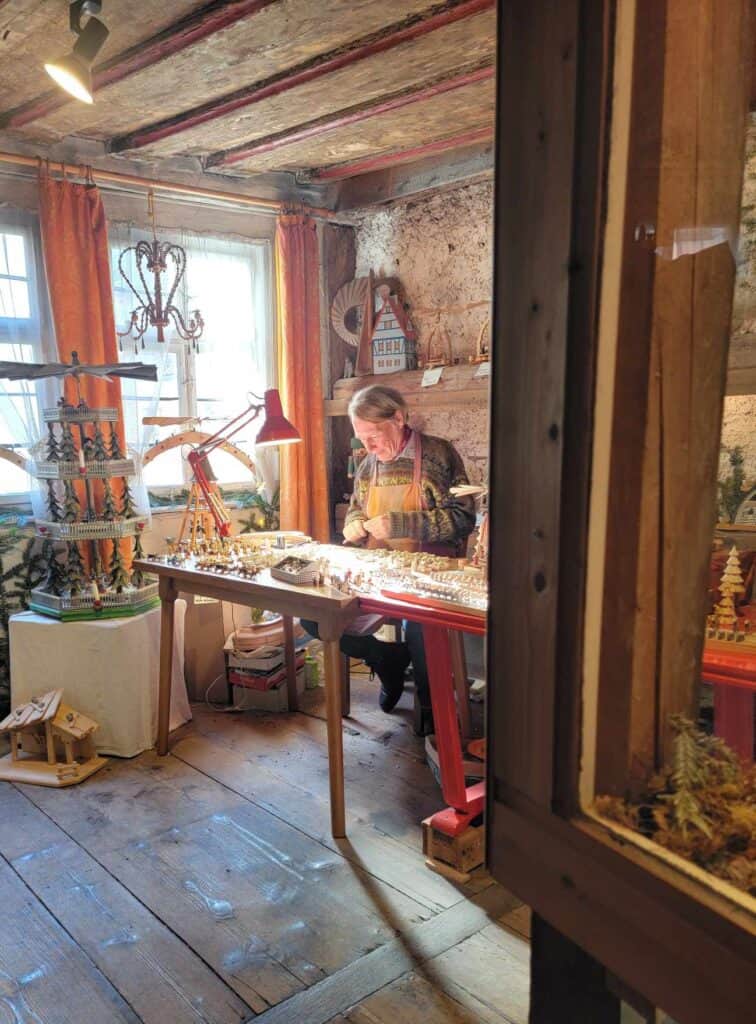
There were many Christmas themed shops in Rothenburg, but this one was special. Upstairs was a workshop where the decor was being hand carved! A little sign welcomed us in so we popped in long enough to tell them we loved their products and then let them get back to work. I felt like I’d stepped into Gepetto’s workshop!
Of course we ended up buying gifts and souvenirs from this very unique place.
Where to Eat in Rothenburg ob der Tauber
41) Zur Höll Restaurant (Oldest wine tavern in the city)
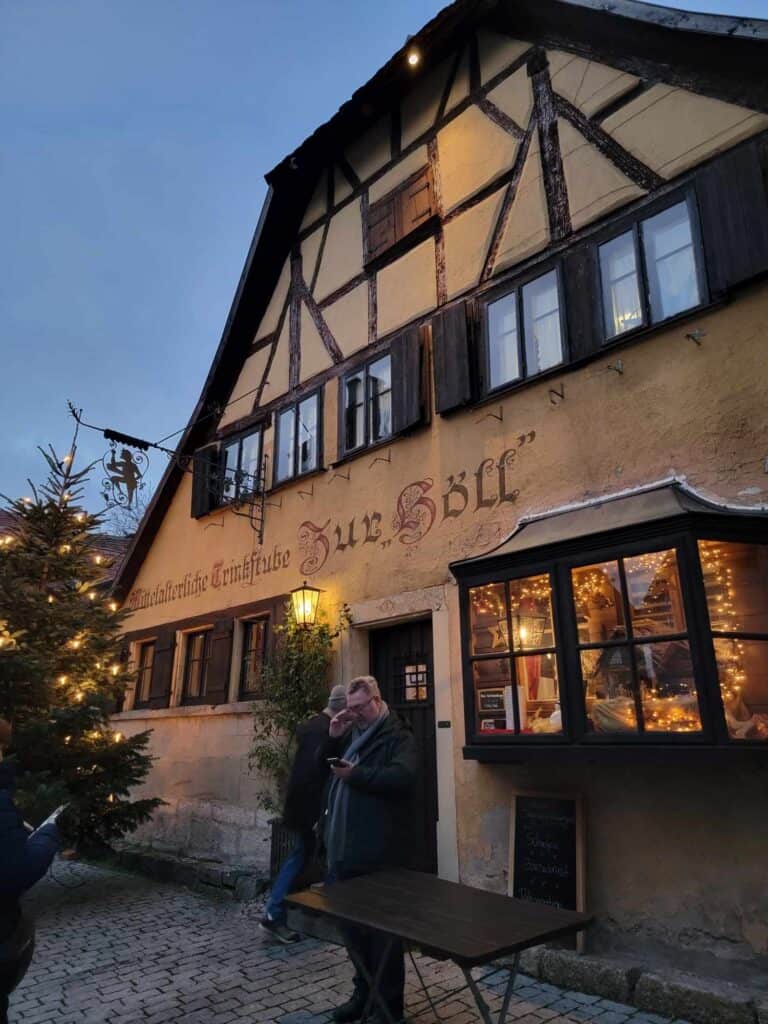
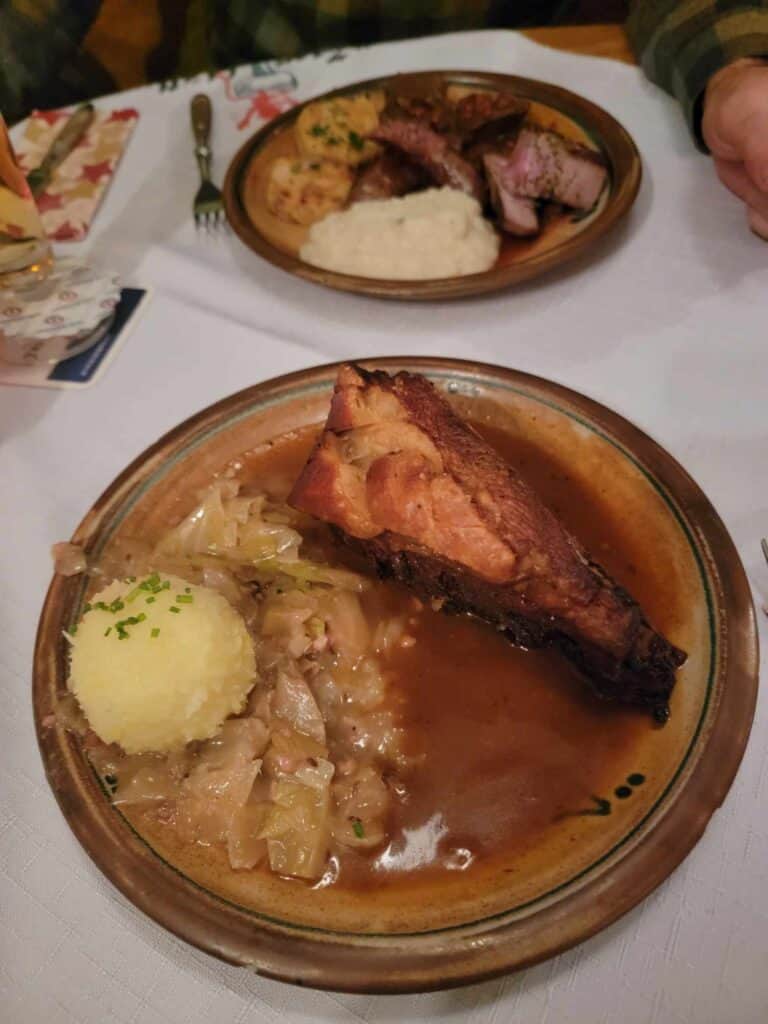
Zur Höll, Rothenburg’s oldest wine tavern, dates back to the 10th century. Höll, in German, means Hell, and all I have to say is if there were a restaurant like this in Hell, there’d be a line to get in!
Dine on hearty Franconian dishes like pork loin, stews, and soups, in a cozy, candlelit setting steeped in history. We always like to find the oldest restaurant in every city, and this one was a real treat!
Absolutely make reservations in advance. If you didn’t, and you really want the experience, try showing up at 5-5:30 and see if you can get their first seating. Germans usually don’t like to eat until much later.
42) Alter Keller (Scrumptious Traditional German/Franconian)
Alter Keller 8
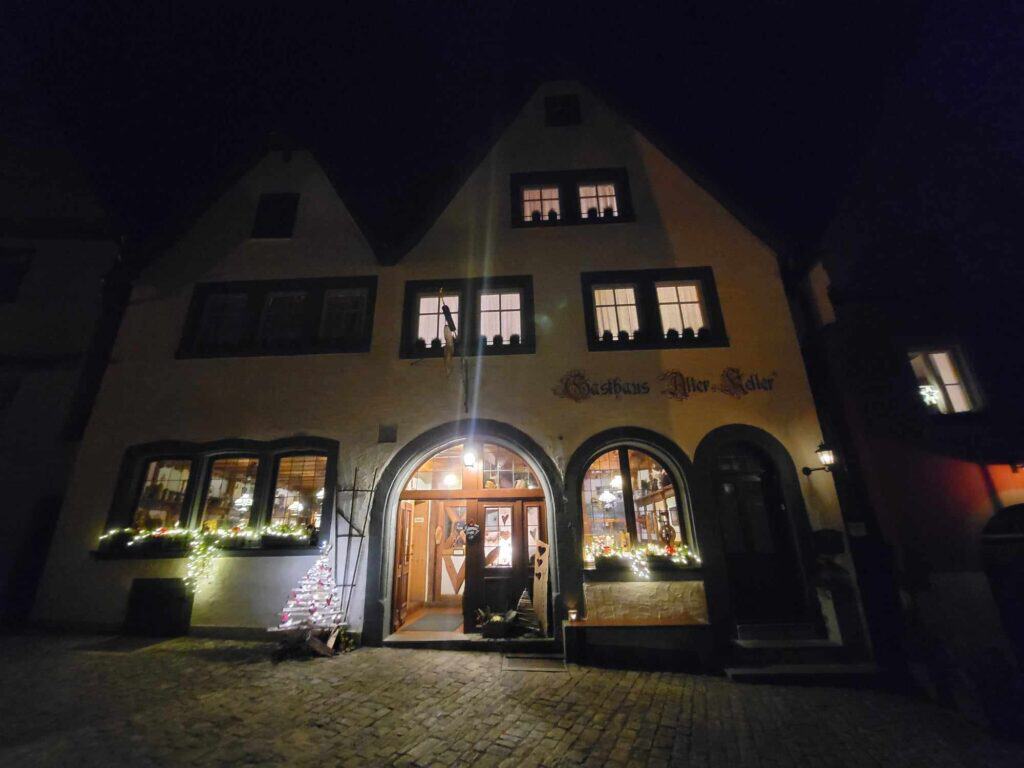
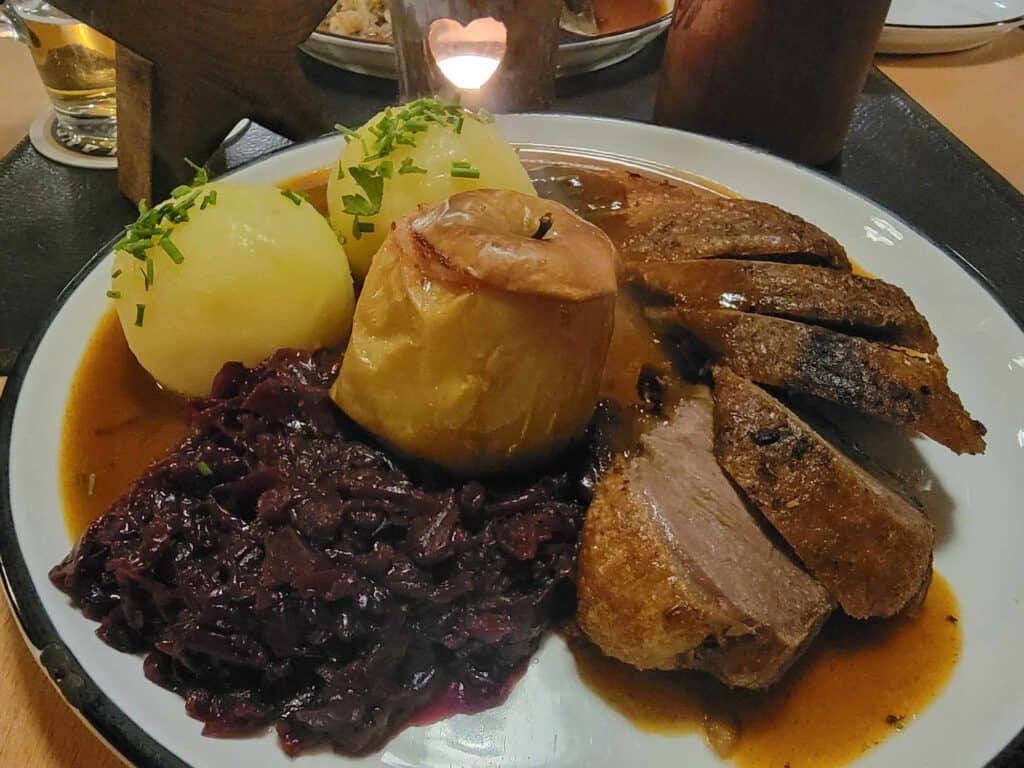
The fare here at Alter Keller (Old Cellar) won our hearts in a big way. As I type this my mind is wandering back to a bowl of chestnut soup that was absolutely spectacular. We actually ate our “Thanksgiving” dinner here, although nobody celebrates Thanksgiving outside the US, we thought our meal stacked up and made a perfect replacement!
Definitely make reservations ahead of time!
43) Tobingo (Döner, Schnitzel, and quick bites)
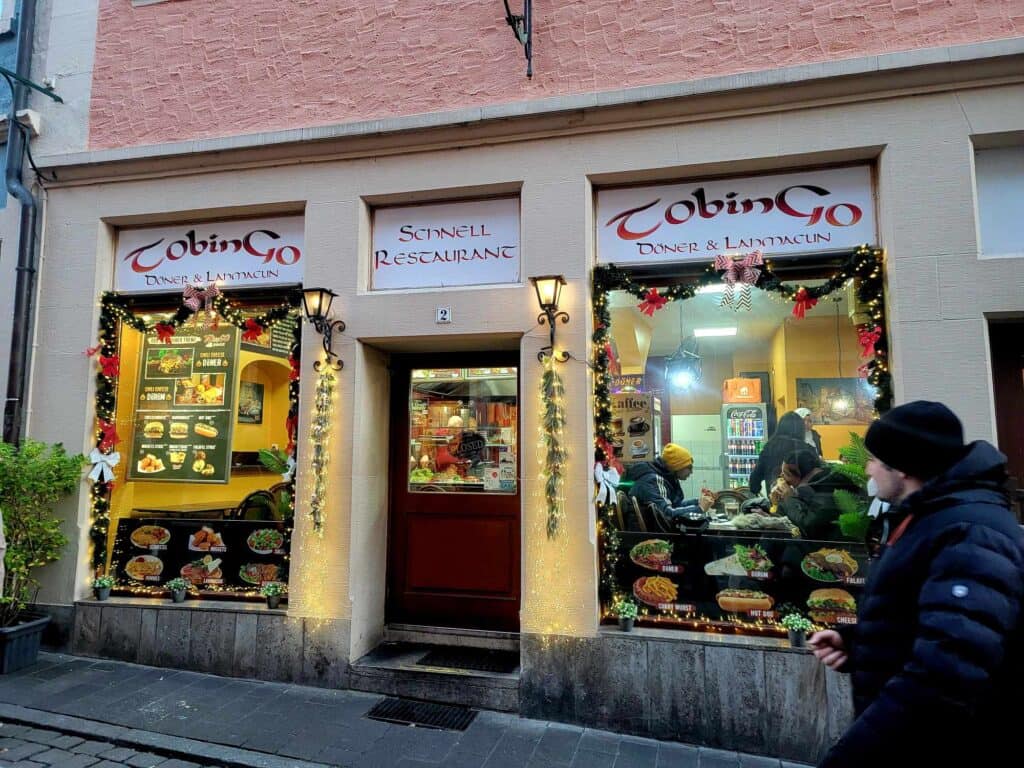
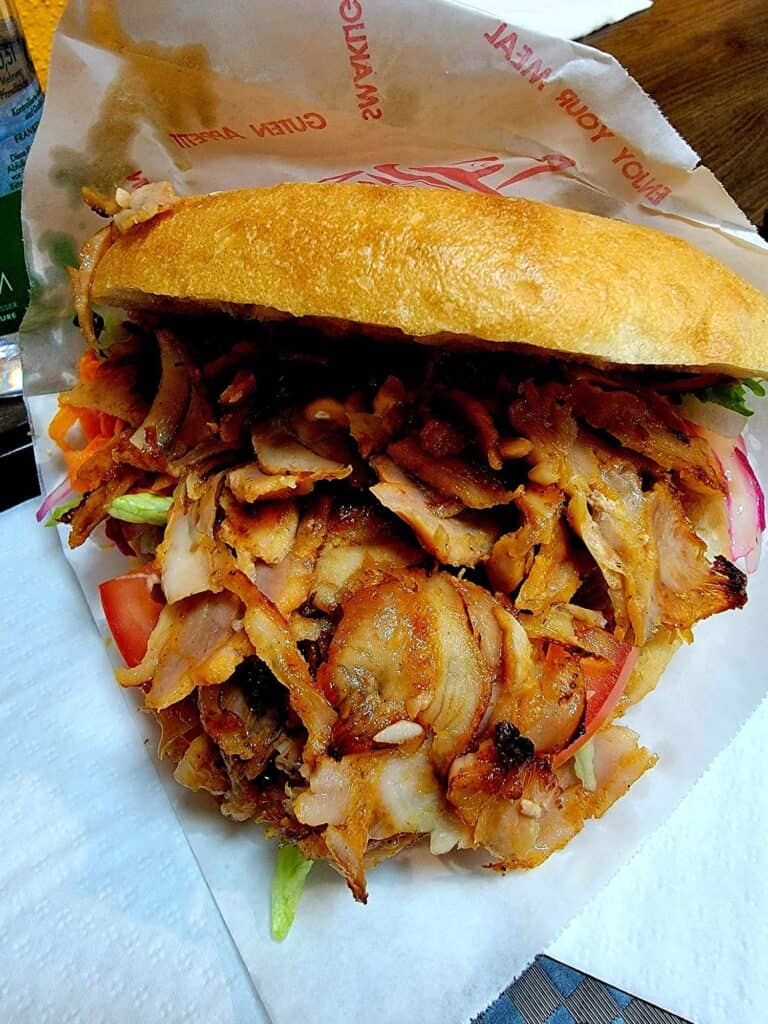
If time is limited, and you need to stuff something in your face, we’re going to recommend this awesome döner kebab spot. Schnell means fast, and this was some pretty great fast food! Flavorful, satisfying, and quick! Perfect for a quick pit stop to fuel up for our late afternoon adventures.
44) Bräustüble (Coffee and cake)
Alterstadtgraben 2
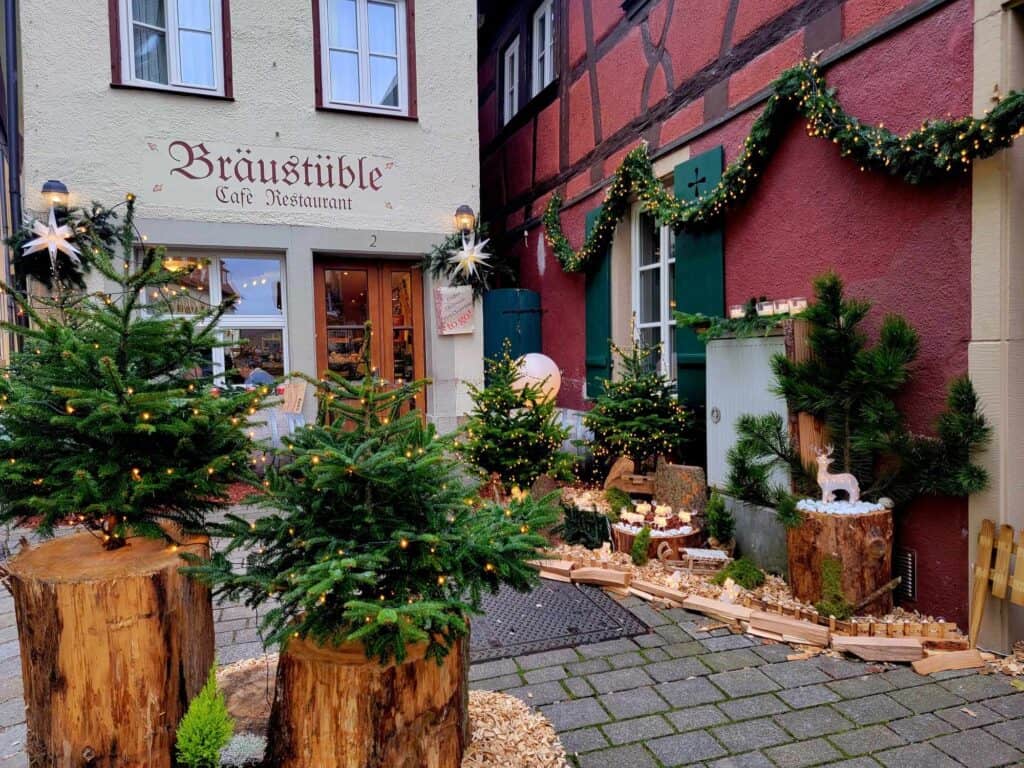
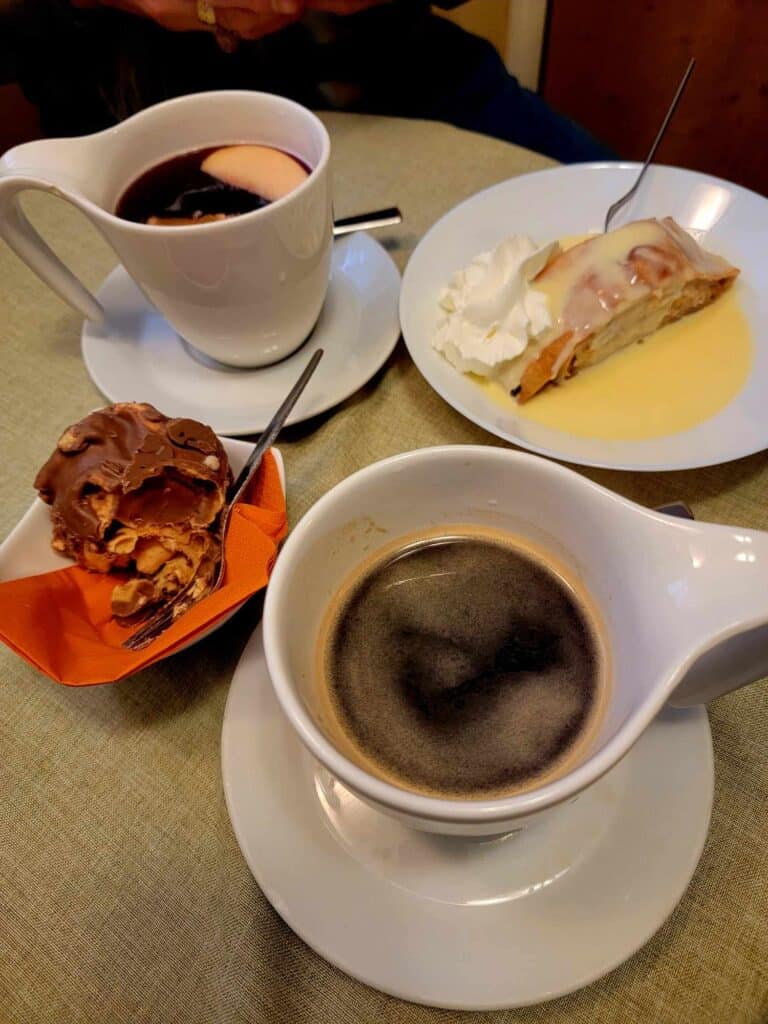
We stopped here for “Kaffee und Kuchen,” the German tradition of afternoon coffee and cake, for the best apple streudel I’ve ever had in my life. It was as light as a cloud and covered with some kind of sticky vanilla sauce and whipped cream and …omg.
45) Check for Storks!
Depending on the time of year, you could luck out and see the storks nesting on their platform atop the Markusturm! And this ends the magical list of things to do in Rothenburg ob der Tauber!
How Long Do You Need in Rothenburg ob der Tauber?
Ideally, 2-3 days should be perfect to really get a feel for the town and see the major attractions and highlights. This allows you a little time to breathe and wander and soak in the atmosphere, go to a museum or three, do some shopping, sample a couple restaurants, take the night watchman tour, and knock off most of the list above.
If that’s too long for your schedule, do try to spend at least one overnight so you can take the Night Watchman tour, and wake up with all those Rothenburg bakeries right outside your door!
That said, don’t skip Rothenburg because you think you don’t have enough time. A day trip from Nuremberg or Munich that gives you a few hours is WAY better than nothing! You’ll probably wish you could stay longer, but even a few hours in this magical place will be memories you’ll never forget.
Is Rothenburg ob der Tauber Dog Friendly?
Yes! Germans love dogs! Even some restaurants and cafés will allow dogs, and you can assume your dog is probably allowed unless there is a sign saying they aren’t. But it’s always a good idea to ask before bringing your dog into a store or restaurant just to be sure.
How to Get to Rothenburg ob der Tauber
🚗 By Car
From Munich: 2 hours 11 minutes
From Nuremberg (Nürnberg): 1 hour 4 minutes
From Frankfurt: 1 hour 38 minutes
From Stuttgart: 1 hour 27 minutes
🚉 By Train
The train station is about a 15 minute walk from the town hall.
From Munich: 2 hours 37 minutes
From Nuremberg (Nürnberg): 1 hour 27 minutes
From Frankfurt: 2 hours 37 minutes
From Stuttgart: 2 hours 43 minutes
✈️ Closest Airports
The closest major airports to Rothenburg ob der Tauber are: Frankfurt (FRA), Munich (MUC), Stuttgart (STR), and Nuremberg (NUE).
Check the weather conditions in Rothenburg ob der Tauber before you travel!
Where to Park
There is lots of parking in the area that you can find with Google Maps, but the best and most convenient is right by the Galgentor and is designated as P4, where there are 3 lots right next to each other and directly at the entrance to the walled city. There are machines where you can pay and put the ticket on your dashboard.
Restrooms
You’ll find nice clean public restrooms right next to the Galgentor as you enter the city.
See You in Rothenburg ob der Tauber!
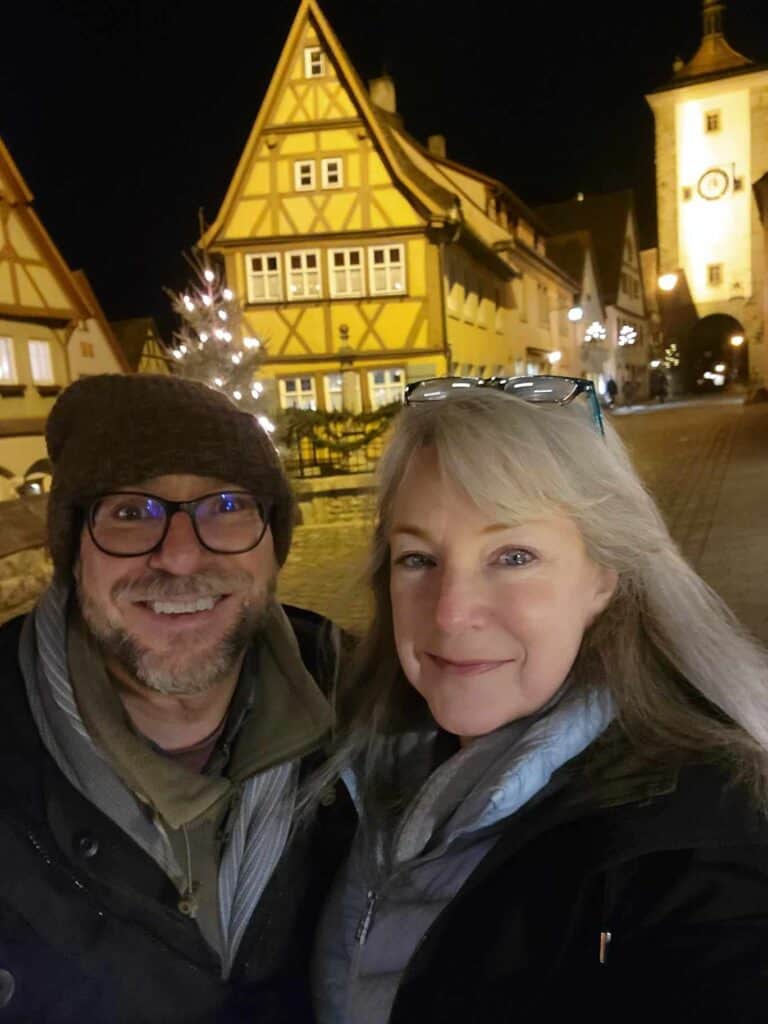
I’ve lived and traveled extensively in southern Germany for years now, and I’ve seen some amazing and beautiful places. But Rothenburg ob der Tauber is definitely among my absolute favorites!
It’s a place that so completely transports you back in time, that just seeing a car feels startlingly out of place. It is full of authentic charm, cozy eateries, fascinating history, great museums, and really has something to leave almost everyone spellbound.
Other Posts You Might Enjoy:
Rothenburg ob der Tauber Christmas Market: Medieval Magic Awaits!
25 Best Things to Do in Nuremberg: History and Hidden Gems
One Day in Bacharach: Best Guide to Germany’s Hidden Gem on the Rhine
11 Best Things to Do in Marburg: Germany’s Fairytale Town
One Day in Bamberg: Best Guide to Germany’s Medieval Beer Capital
The Perfect Weekend in Cologne
